Today is the day I leave Cusco and visit the Sacred Valley. This valley lies between Cusco and Machu Picchu and must be traversed in order to get there. It is an absolutely breathtakingly beautiful valley, with enormous mountains on either side, fertile farming villages in the heart of the valley, and terraces and ruins dotting the mountain sides.
Llama Time
I begin the day with hotel breakfast. I actually got up early enough to slow down and enjoy breakfast before today’s guide arrived. I really enjoyed the various quinoa items, a yogurt parfait and quinoa pancakes. They also have a honey comb dripping fresh honey into a bowl. I also tried algarrobina, which is a syrup made from carob trees, and found it to be absolutely delicious.
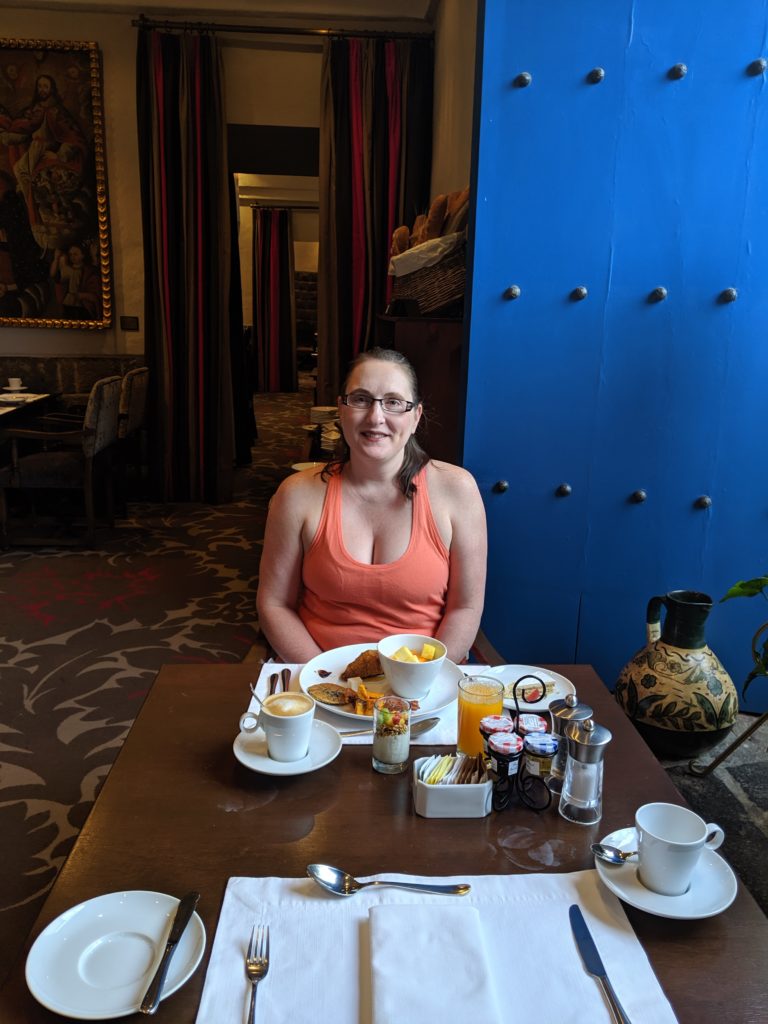
Breakfast at the Palacio del Inca 
Sugar-filled breakfast with fruits, a honey drizzled croissant, quinoa pancakes, and a quinoa parfait 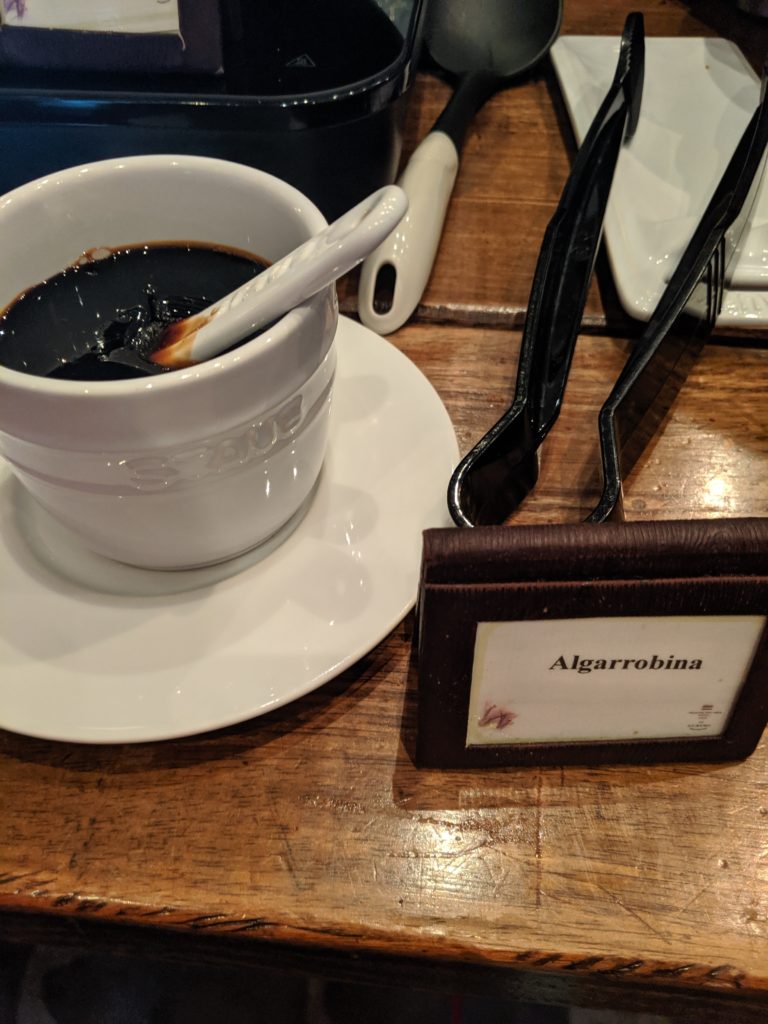
Algarrobina looks like black strap molasses, but tastes even better, lacking that strong aftertaste 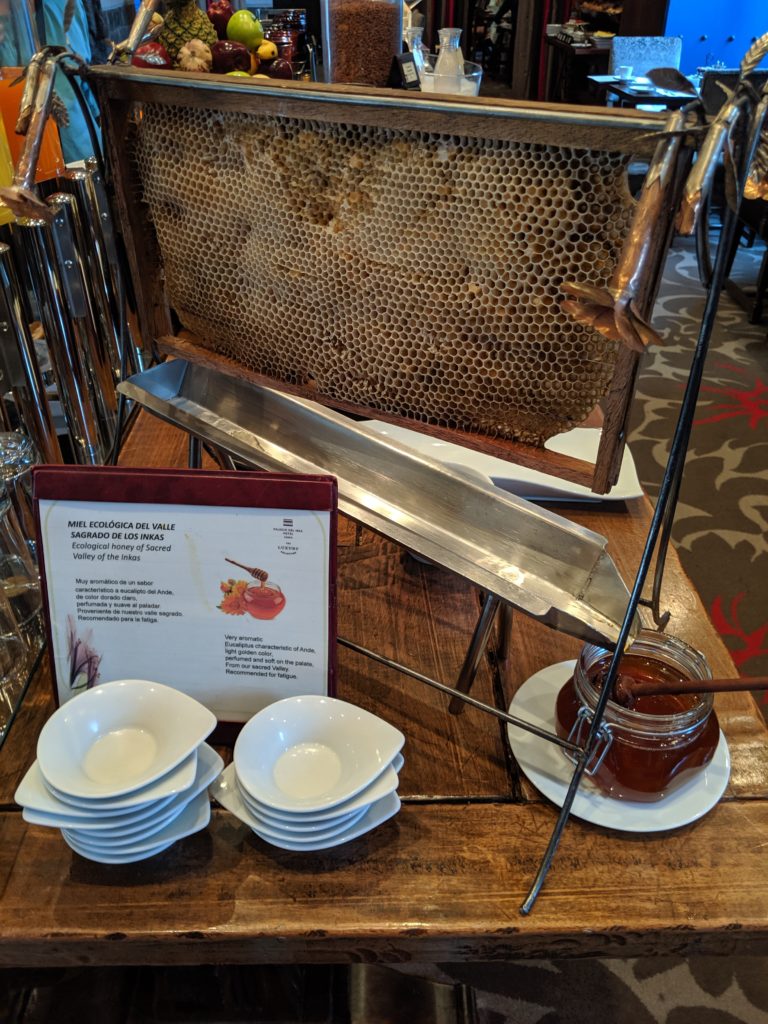
Fresh honey
At 8 a.m., my guide for the day, Freddy, arrives. There are 2 places along the way that have llamas and alpacas. I have requested to visit both, and Freddy is like ‘are you sure you want to do both?’ and I say yes. One of them has llamas that you can touch and one has llamas in a pen you can look at, but has more information. While I have had less than a week to plan this trip (I bought tickets on a Friday and boarded a flight the next Thursday!), I have made time to research where I can commune with the llamas.
Ccochahuasi
Our first stop is Ccochahuasi animal sanctuary. This is a place that rescues mistreated or injured animals and, when possible, releases them back into the wild. When we arrive, they already have a few tour groups going, and they ask if I’d be willing to join another group that had just arrived, as they don’t have enough guides. I agree to it, and the group, 5 American tourists, wait with their guide in their van until a guide from the sanctuary is available. Now, here’s where Freddy is like seriously one of the best tour guides ever. Instead of just hanging out, waiting 5-10 minutes for our guide to show up, he notices a worker feeding the llamas. Freddy is a smooth talker, clearly everyone’s friend, and has no problem getting around and getting what he wants. So he takes me down to where the llamas are being fed, and they let me ‘help’ and hand hand feed the llamas and alpacas. Freddy even takes my phone and takes a bunch of photos while I just pet all the llamas.
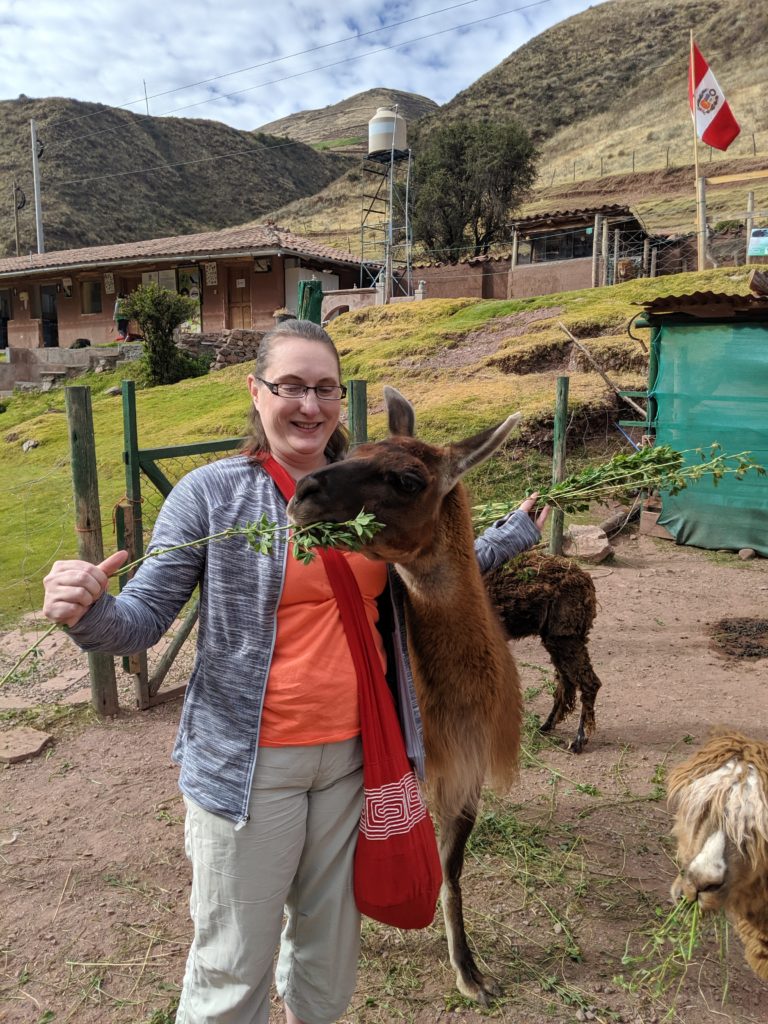
This guy was a rather aggressive food hog 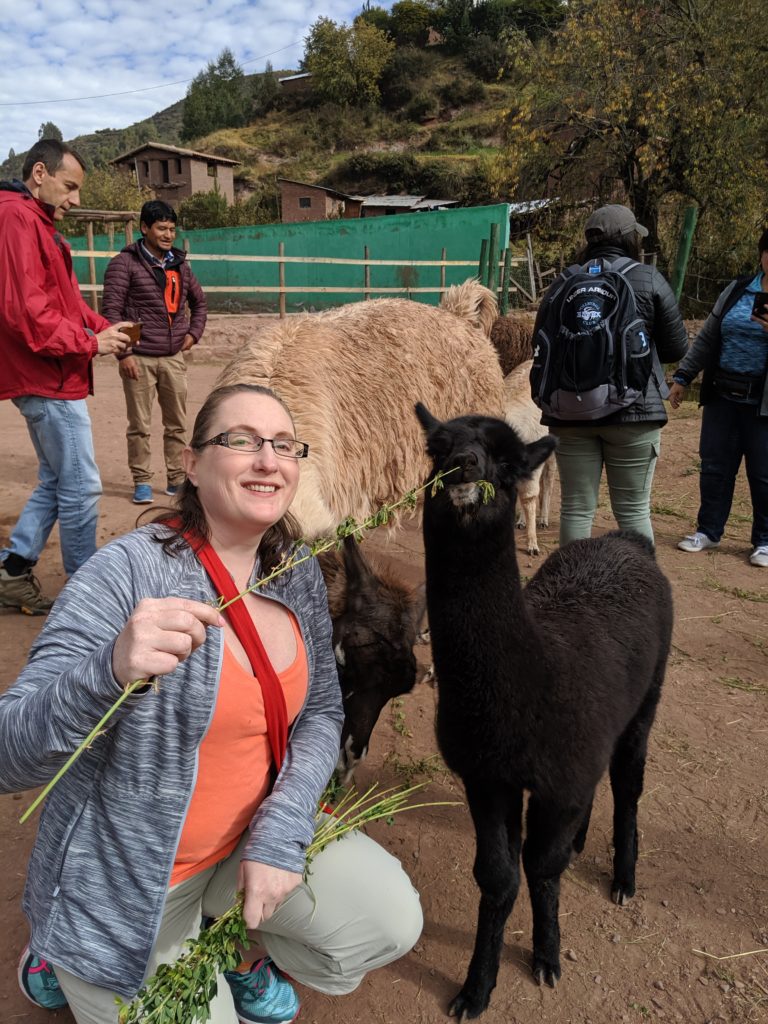
Tiny little Llana with her tiny face 
We’re friends 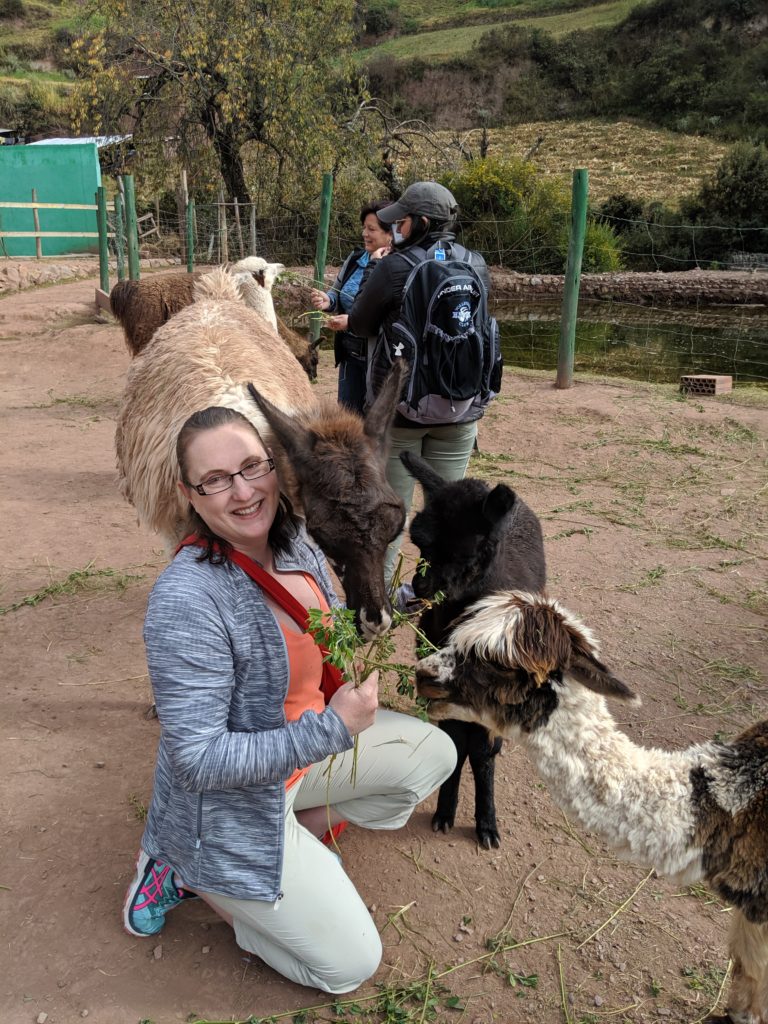
Feeding 3 at once! 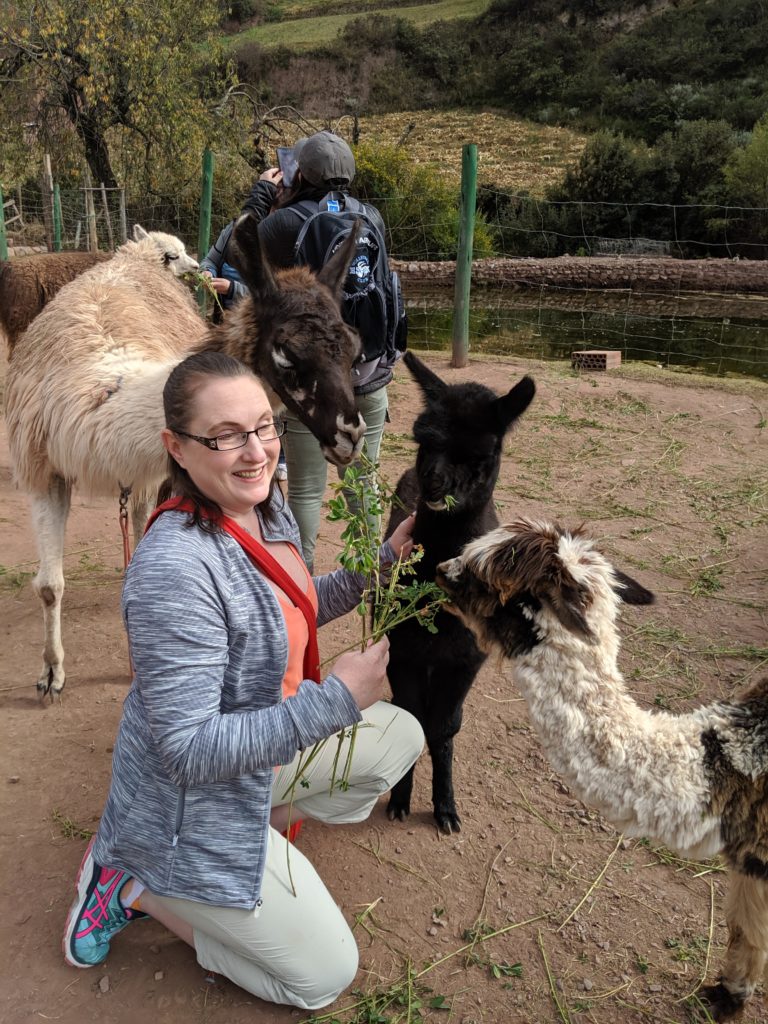
I was trying to feed little Llana, but the bigger ones kept barging in 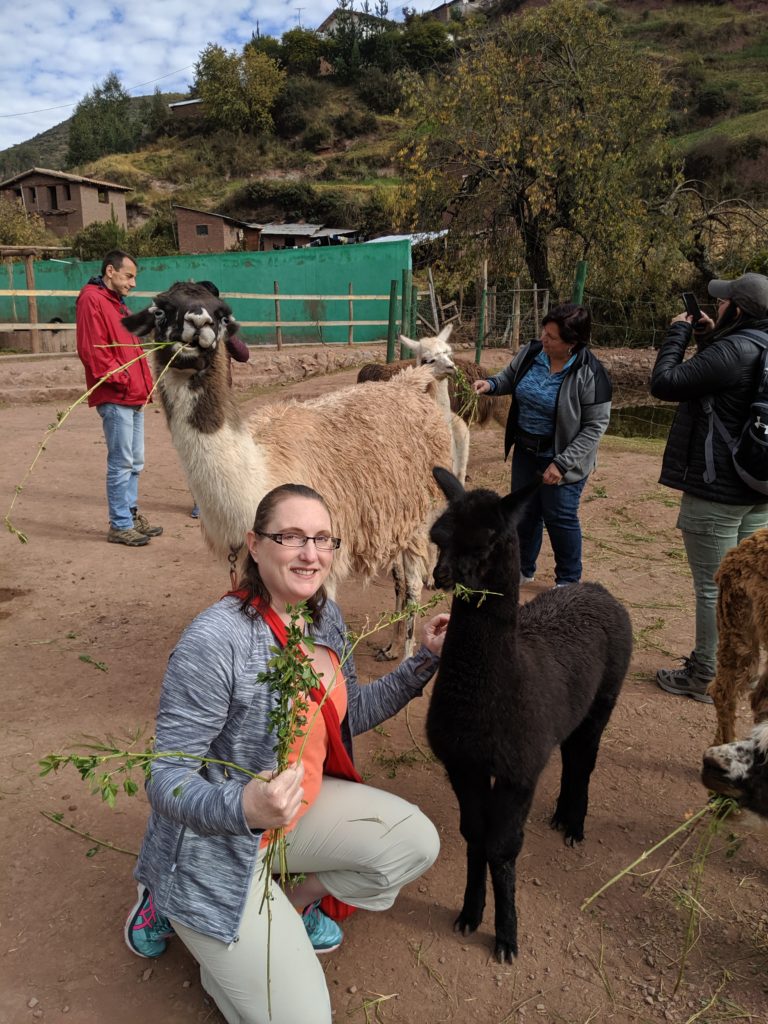
The llama behind me has a very Bugs Bunny look to him: “What’s up, doc?” 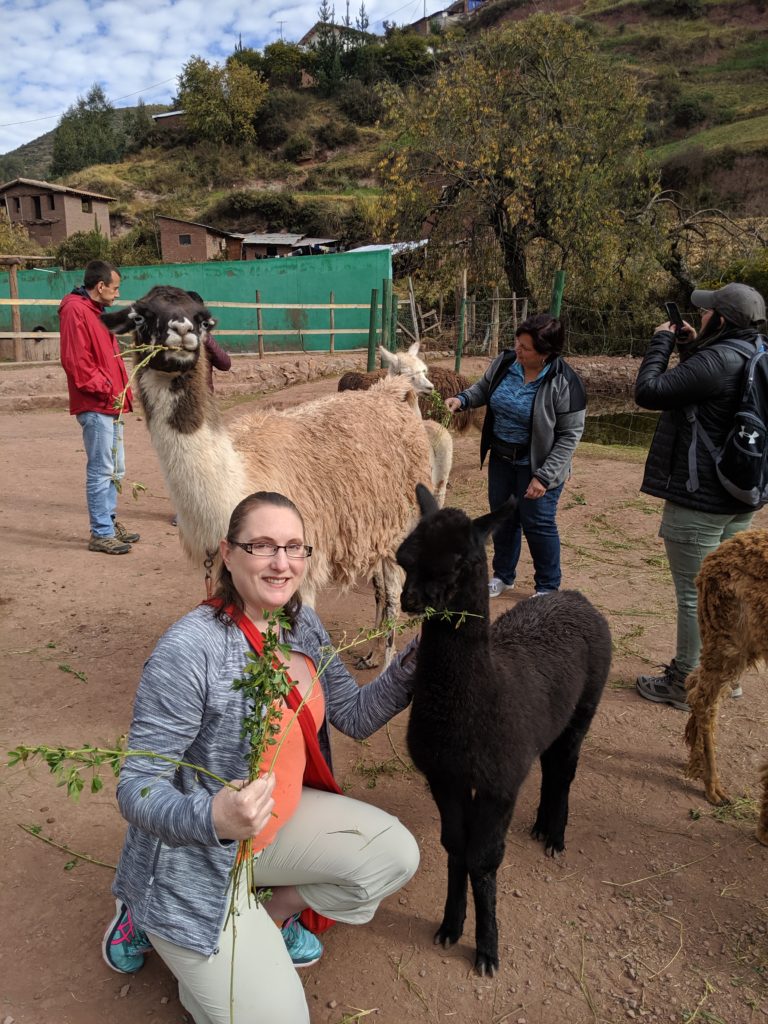
Nibble nibble 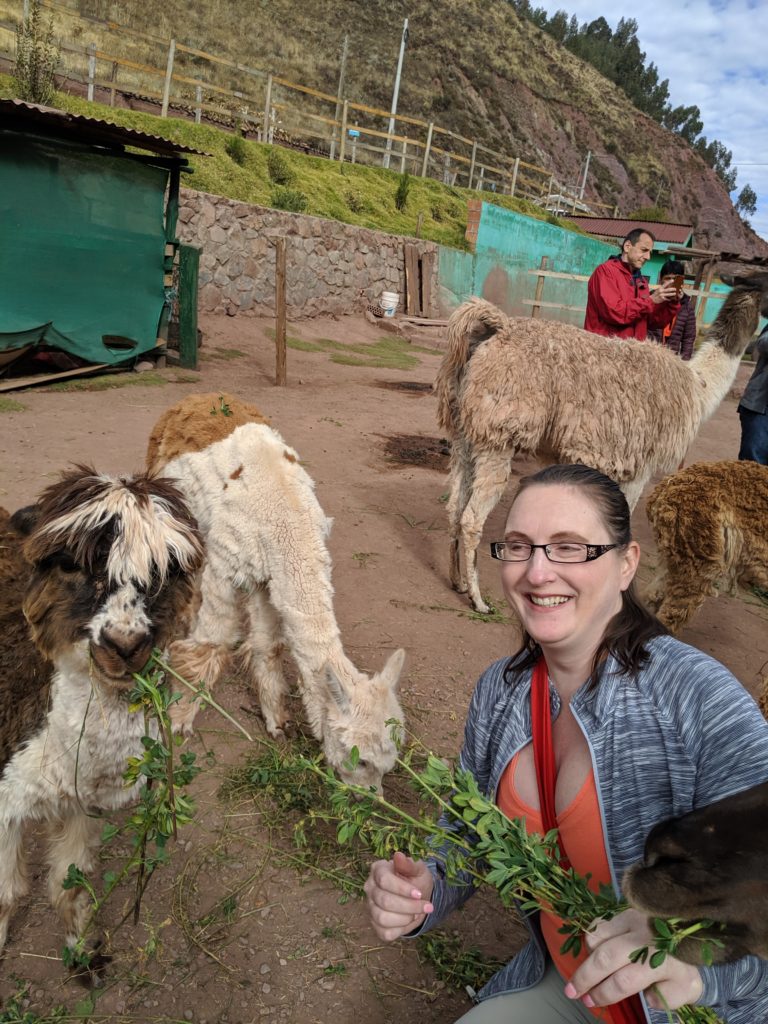
Look at this boi, chomp
We spend our 5-10 minutes hanging out with the llamas, and when feeding time is over, we go back to our tour group, which has passed the vicuñas already and has moved on to the toucan. Vicuñas are hunted in the wild, and have a fairly low population now, because their wool is much softer than alpaca wool and sells for much more. But they haven’t been domesticated enough to supply enough vicuña wool, so hunters still kill them just to shear them. The toucan has part of its beak missing, and can’t be released into the wild until it heals. It’s an adorable and curious bird that comes to the glass and looks quizzically at all of the cameras.
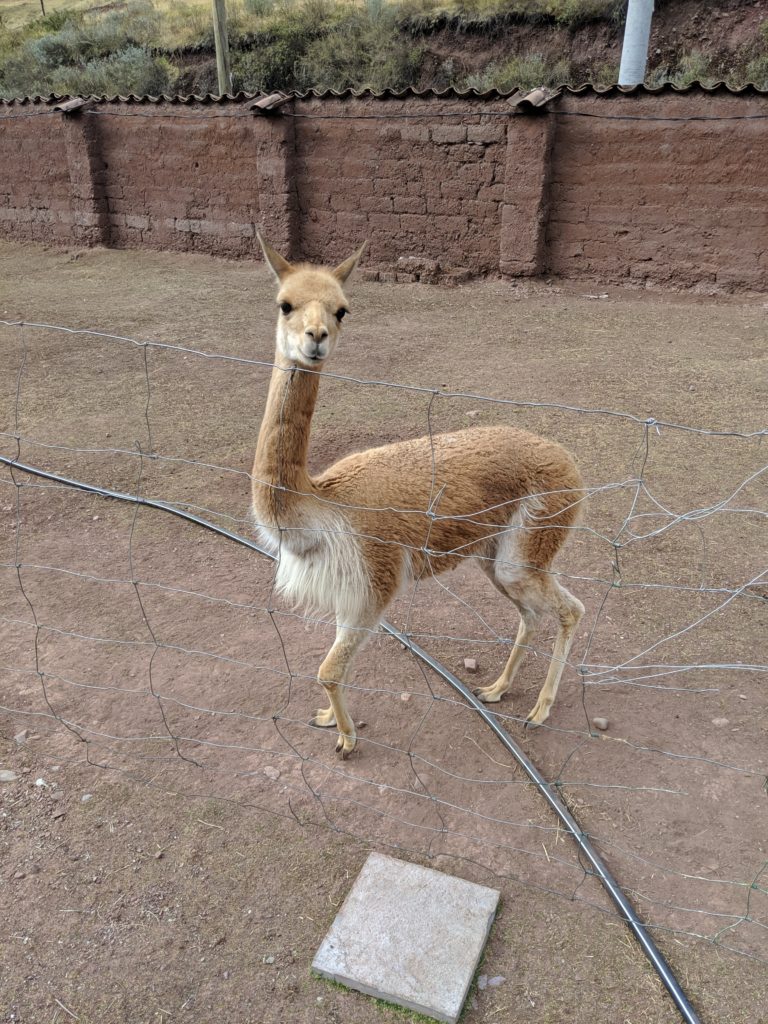
Vicuñas are so tiny and delicate looking 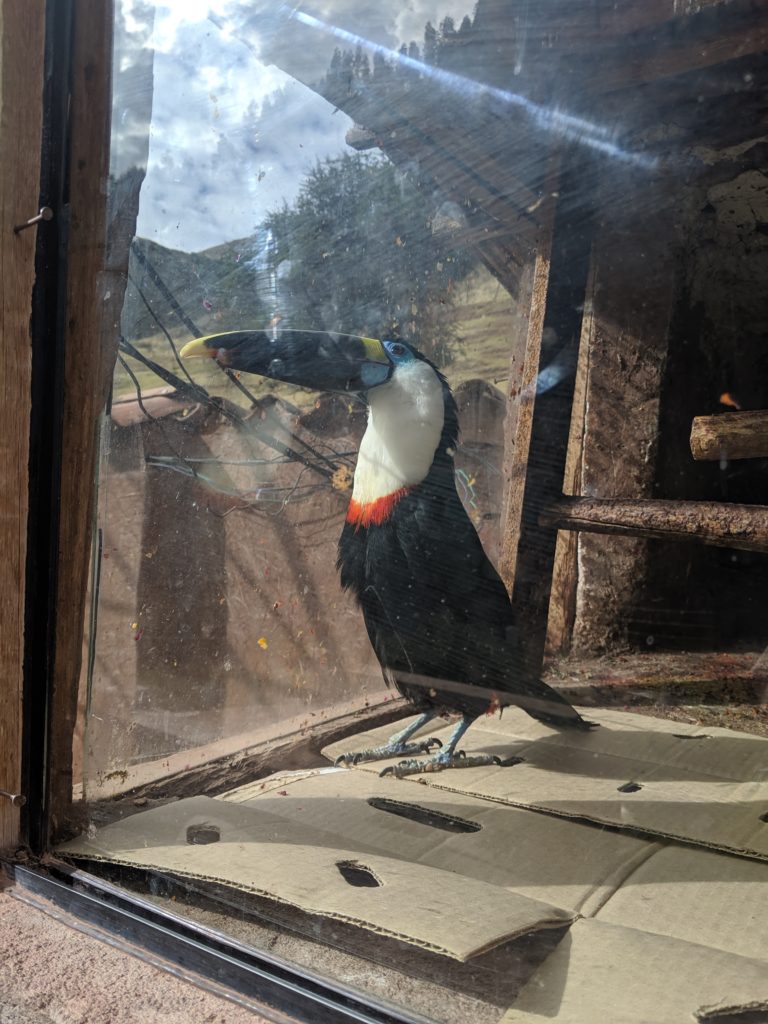
The toucan was quite playful
Next, our tour group visits the llama enclosure. We go in and get to pet all of the llamas and alpacas. They are so soft and super mellow. And they have the most adorably derpy faces. There is one baby alpaca, named Llana, who is only 3 weeks old. She is so soft and delicate and her tiny face seems like her mouth isn’t even big enough to eat the alfalfa. She was very sweet and curious. I kneeled next to her to take a selfie, and she wrapped her neck around me to look at what I was doing, posing for the perfect kiss! They all have just the biggest round eyes that look so calm and sweet. I really just wanted to lay down and snuggle them all!!
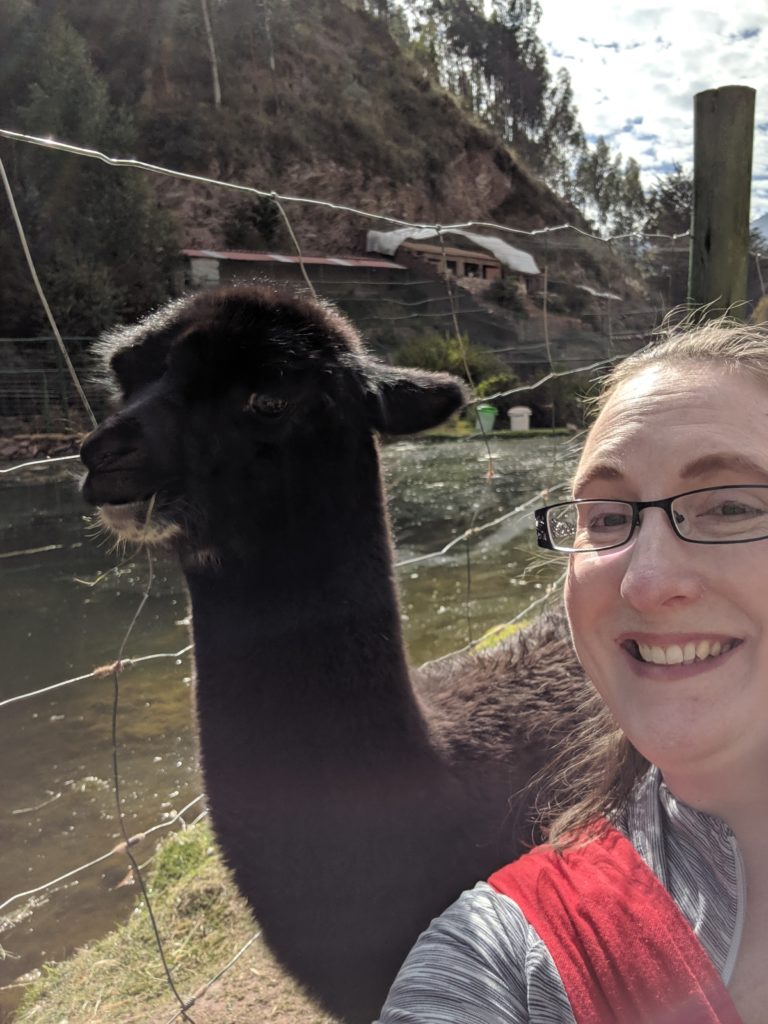
Hey whatcha got there? 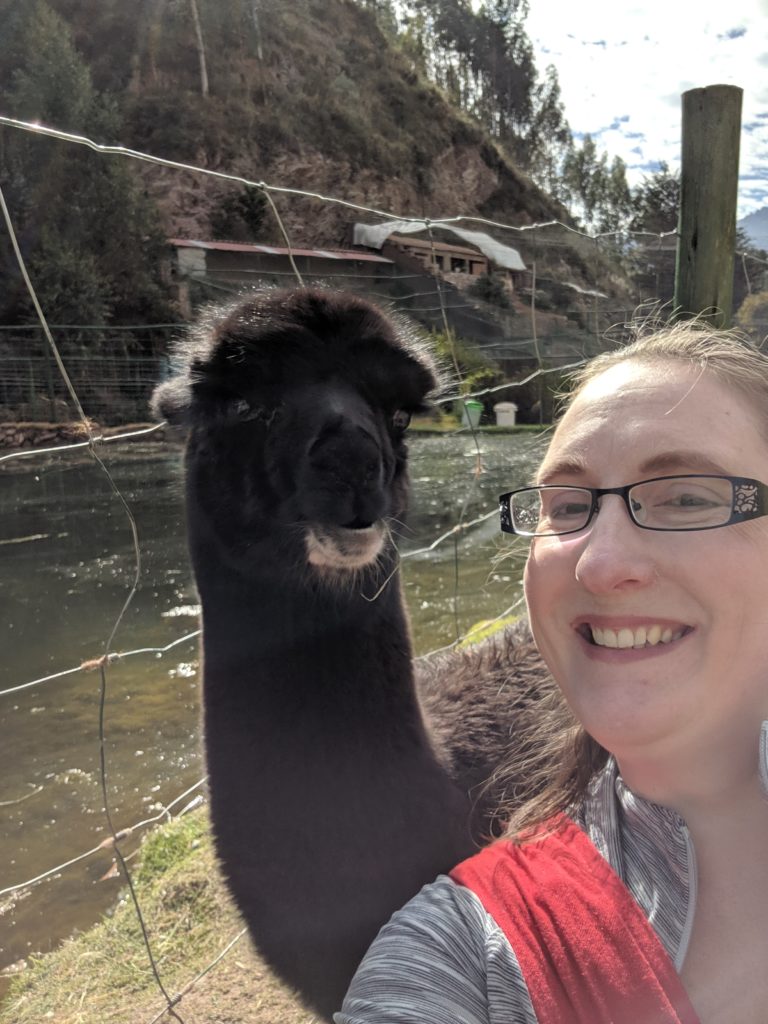
A camera? 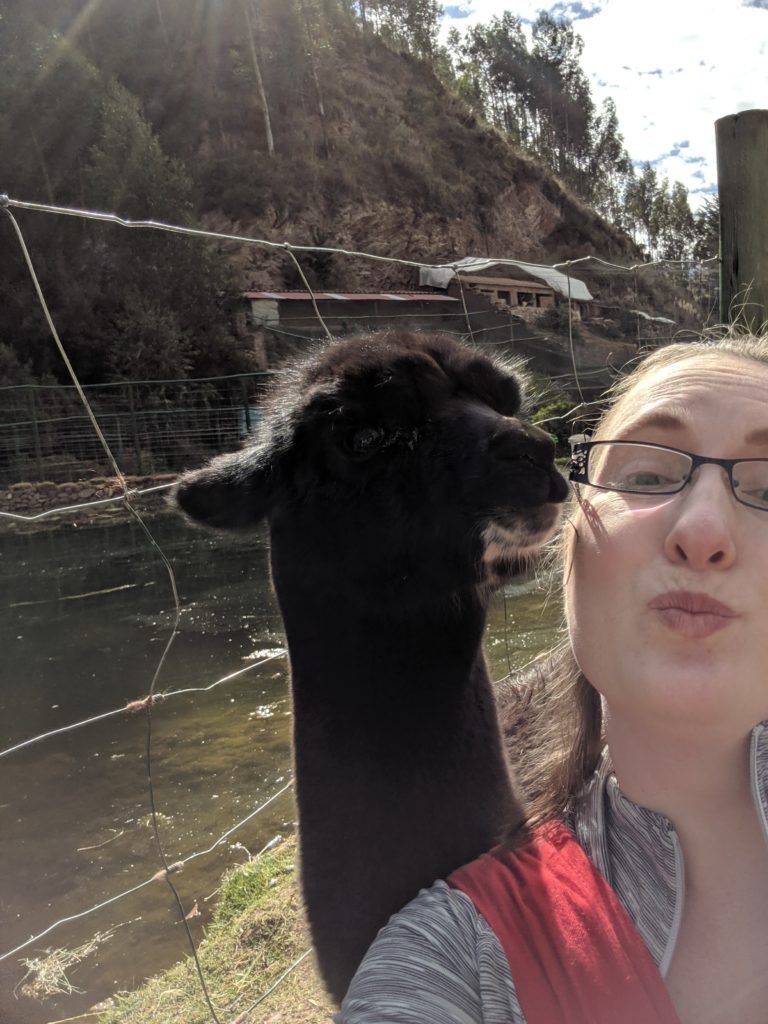
Smooch! 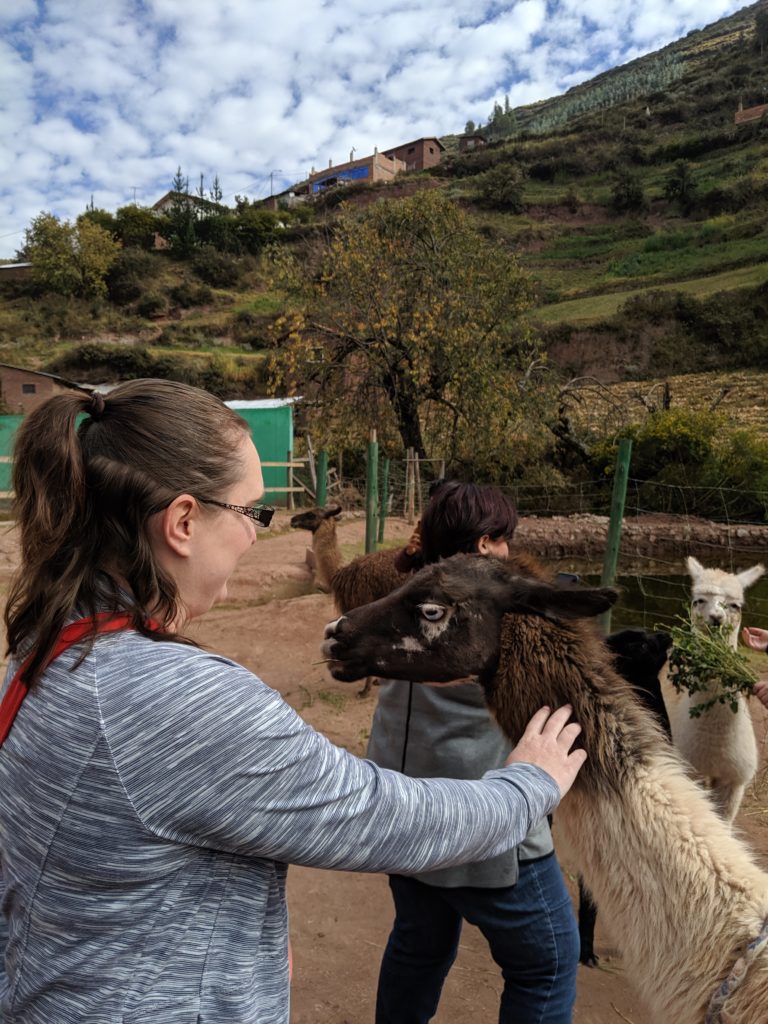
Petting the llamas 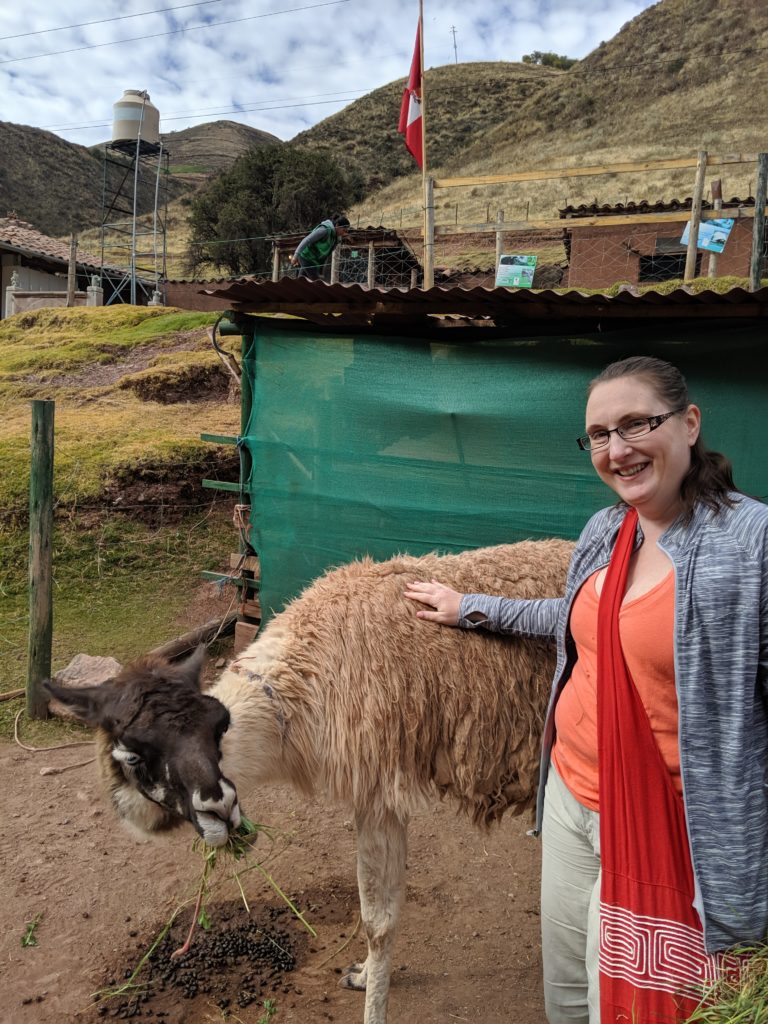
Om nom nom 
Yes please I would like a treat 
This guy has quite an adorable haircut
Next, we visit a hawk. This hawk was hit with a slingshot and is missing one eye, so it cannot be released into the wild. Then we visit a cage with a type of mountain lion/bobcat thing that lives in the Andes. It is the size of a house cat, only slightly larger, and looks like a cute, playful kitty. But apparently they’re also pretty vicious hunters. There also some civets that they have rescued, a small family of them. Civets are popular in other parts of the world for making the world’s most expensive coffee…. as they take civets, feed them coffee beans, and then, uh, ‘harvest’ the beans from the civets’ waste. Here, they don’t force feed the civets coffee beans, but they do make coffee beans available for them and they recover them to sell coffee to fundraise for the animal sanctuary. It is a family owned animal sanctuary with no government funding, only donations. I, of course, had to try the coffee. It’s good, very smooth, lacking a lot of the harsh bitterness of normal coffee. But, it is a bit on the acidic side for my tastes. I kind of like the bitterness. But yay me, I have now tried the world’s most expensive coffee.
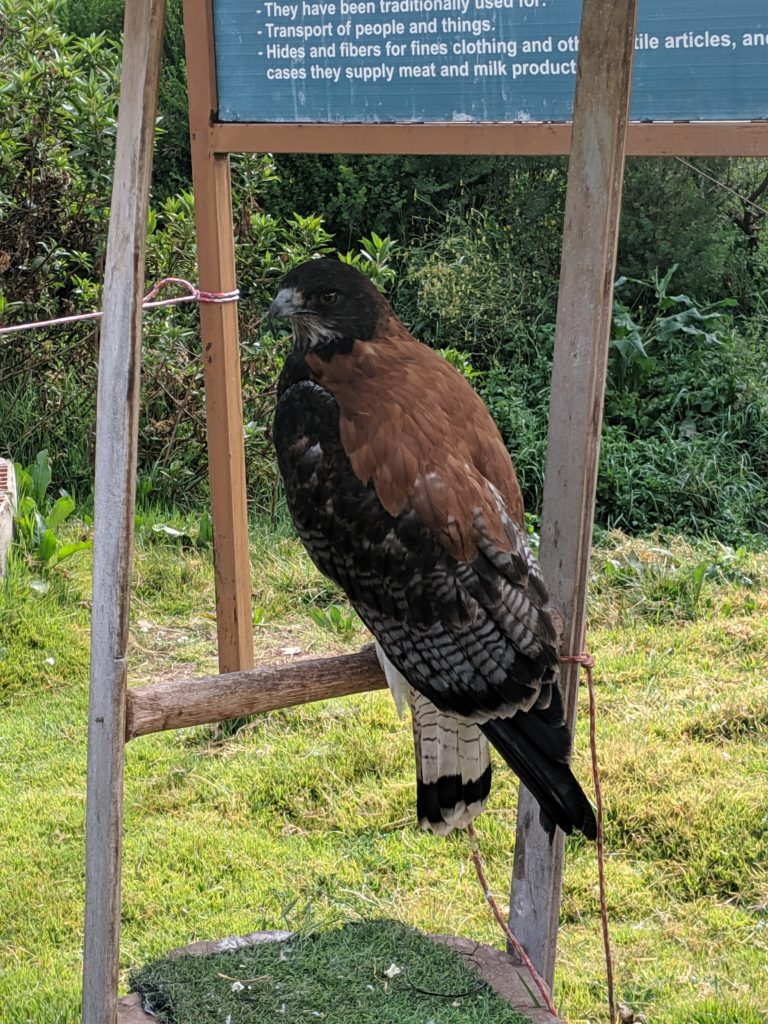
Hawk, just chilling out 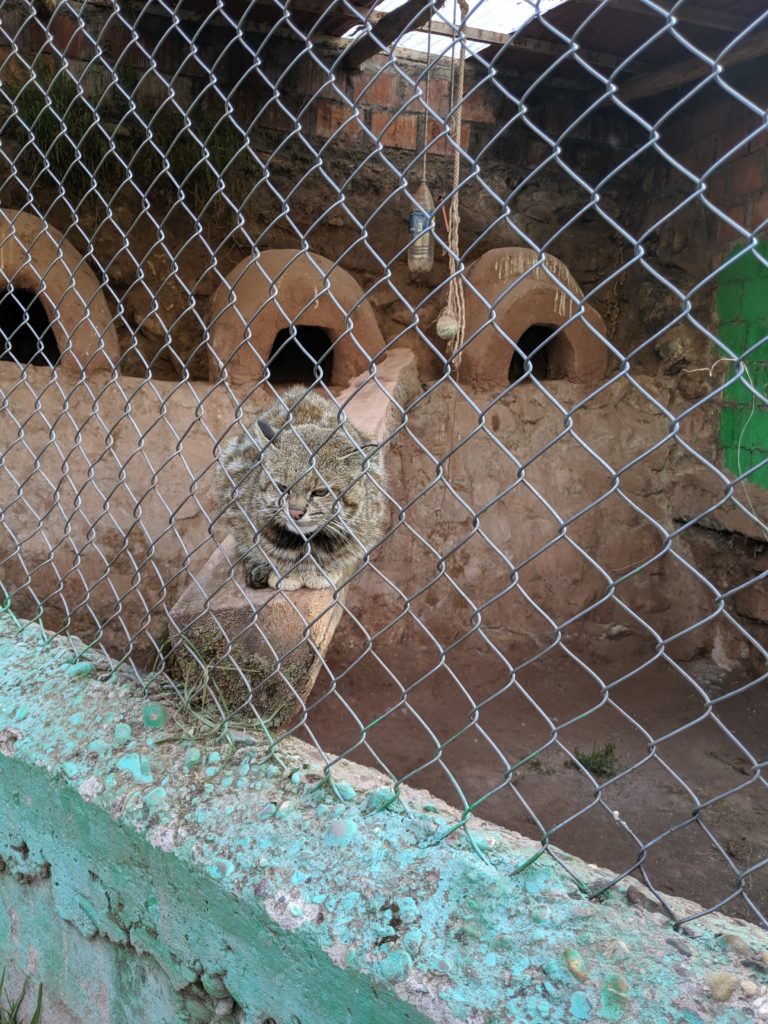
Bobcat type cat 
Tiny bags of special coffee 
And a tiny cup of special coffee 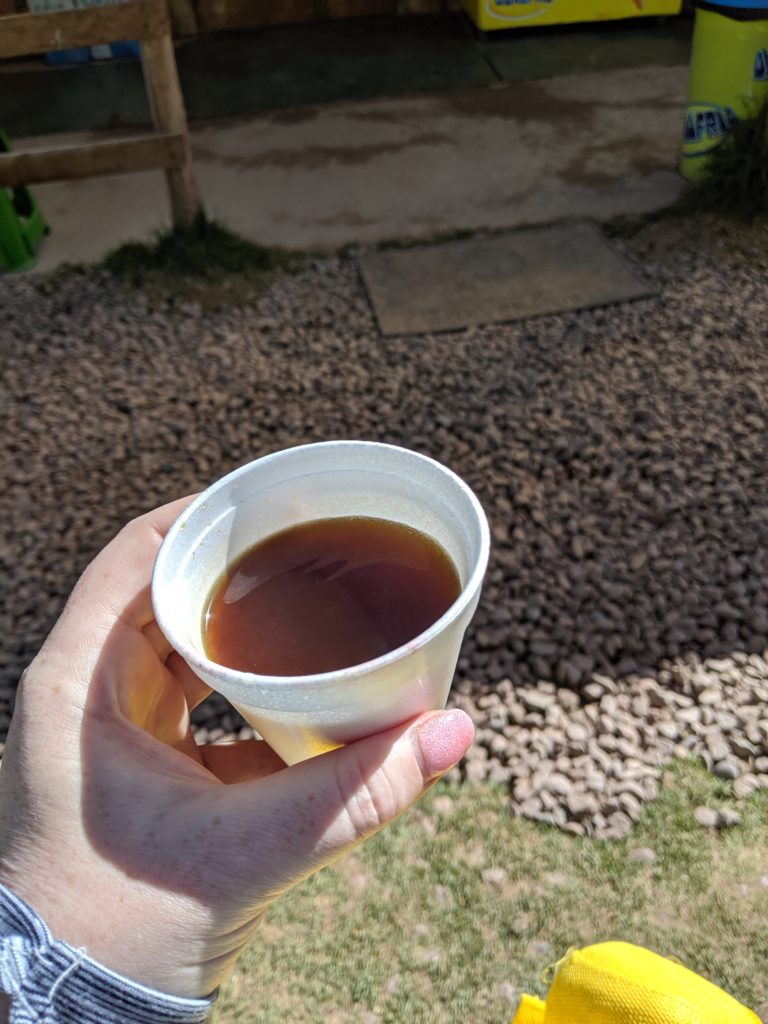
Did I just go to an area of the world where no one can drink the tap water and order a poop coffee?
Then there are pumas. There are 3 or 4 pumas, with a very sad story. They were rescued from a night club in Lima, where they were being held captive to take photos with tourists. They were drugged to keep them from biting the tourists…. and the drugs have left them smaller than normal size, so they are weak and cannot be released into the wild. They have a large, multilevel enclosure, but today, they are just napping in the shade. Next, we visit the condors. Condors are an endangered species, so they breed condors and release them into the wild. When we arrive in the condor enclosure, we are greeted by a huge male condor doing what I assume is just sunbathing. He is standing on the ground, only a few feet from us, wings completely spread out, just standing there. There seem to be 6-10 condors, some adults and some juveniles. The juveniles are released once they are old enough, but most of the adult ones are injured and can’t be released.
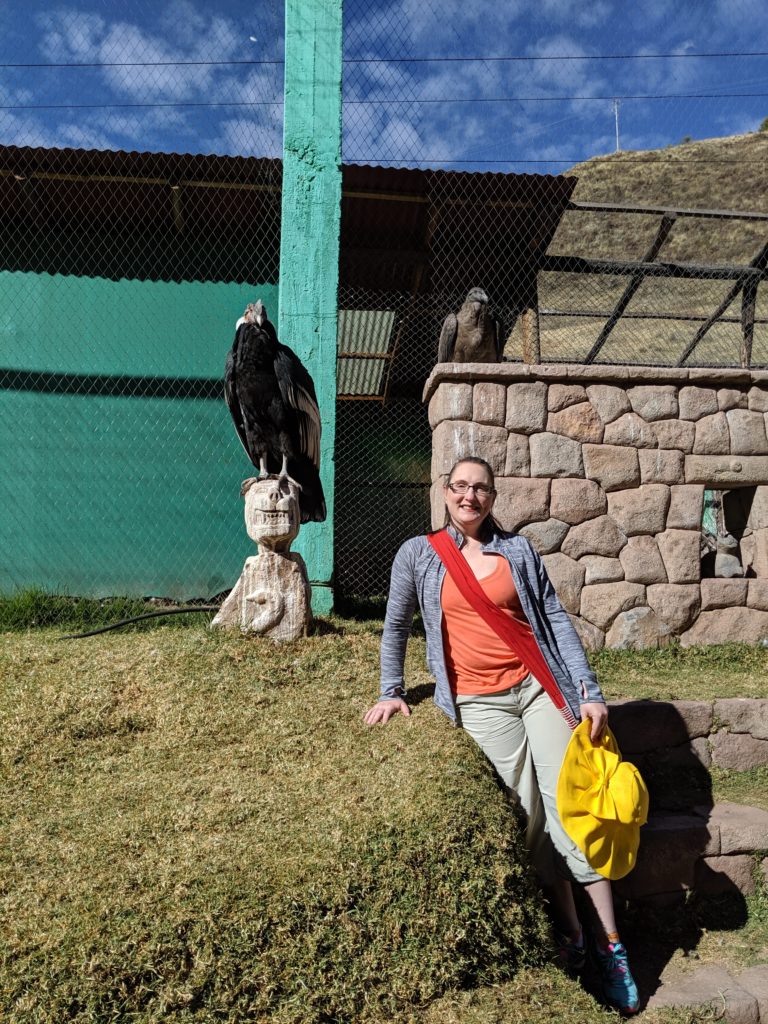
Juvenile condor 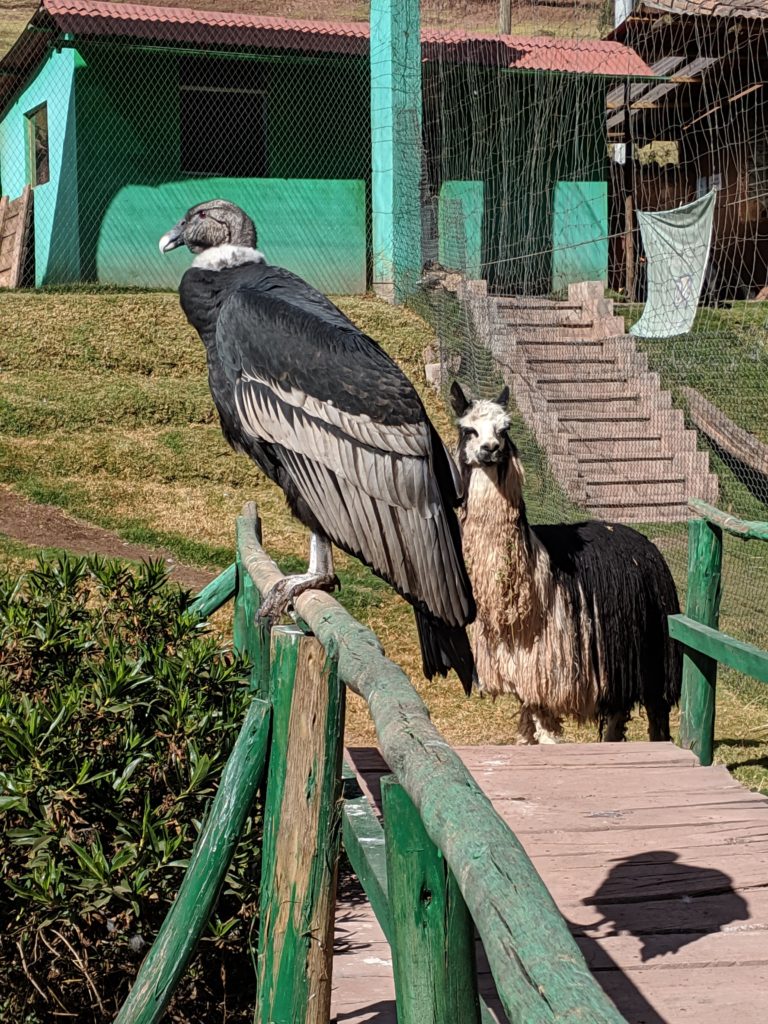
Female condor (no crest) and a llama 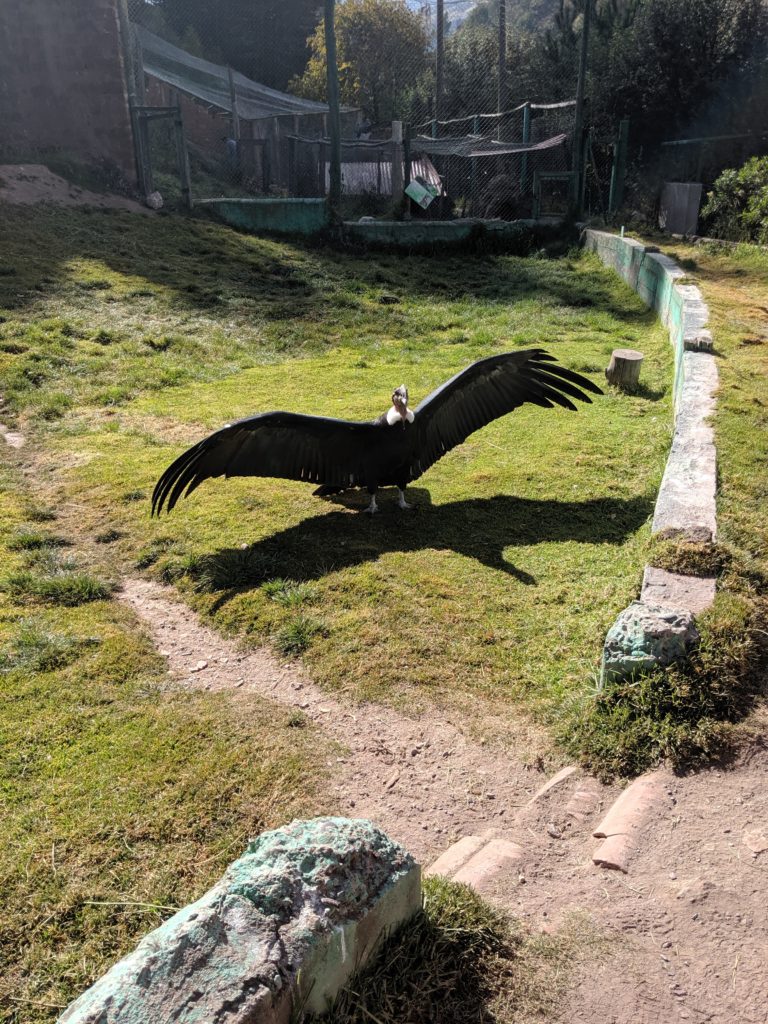
Male condor (with crest on top of head) sunbathing 
Just hanging out in the morning sun
Finally we visit a thatched roof building where we are shown how the wool from the alpacas and llamas is processed. There are lots of colors of wool yarn, and a collection of local plants and things that are used to dye the yarn its distinctive colors. There is a lady in full folk dress demonstrating how to weave cloth from the yarn, using an old loom. She is weaving a pattern with different animals, and she has memorized the patterns from years of weaving. From here, I make a donation to the animal sanctuary and we go to our next stop.

Different colors of yarn from natural dyes 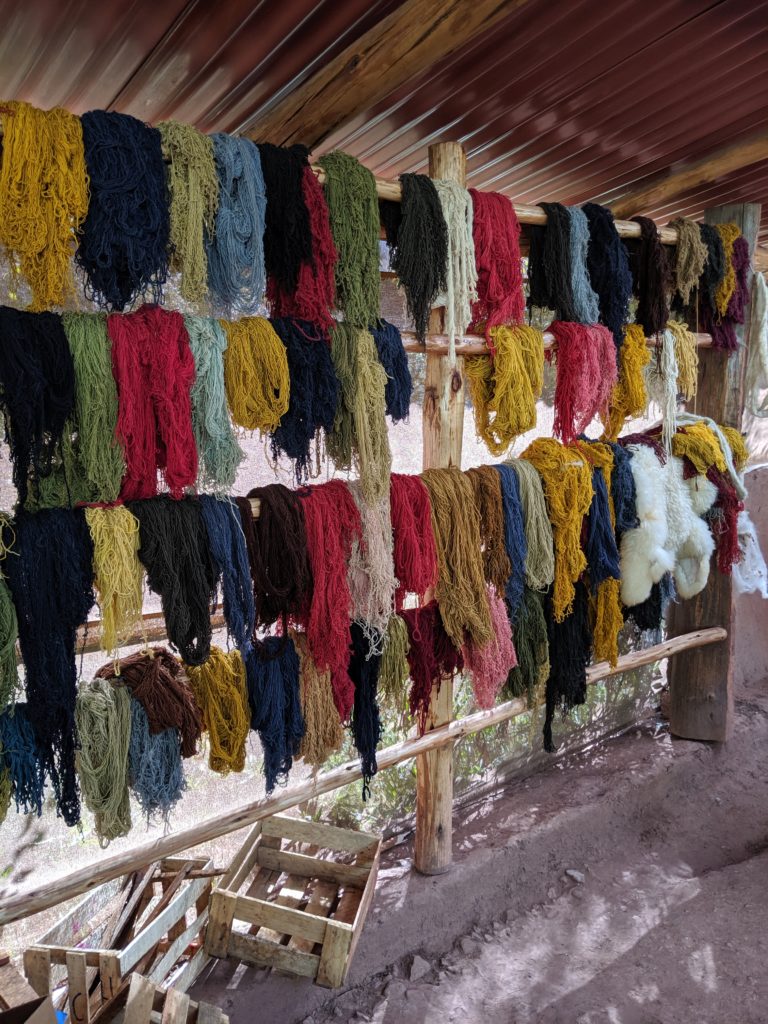
An array of yarns 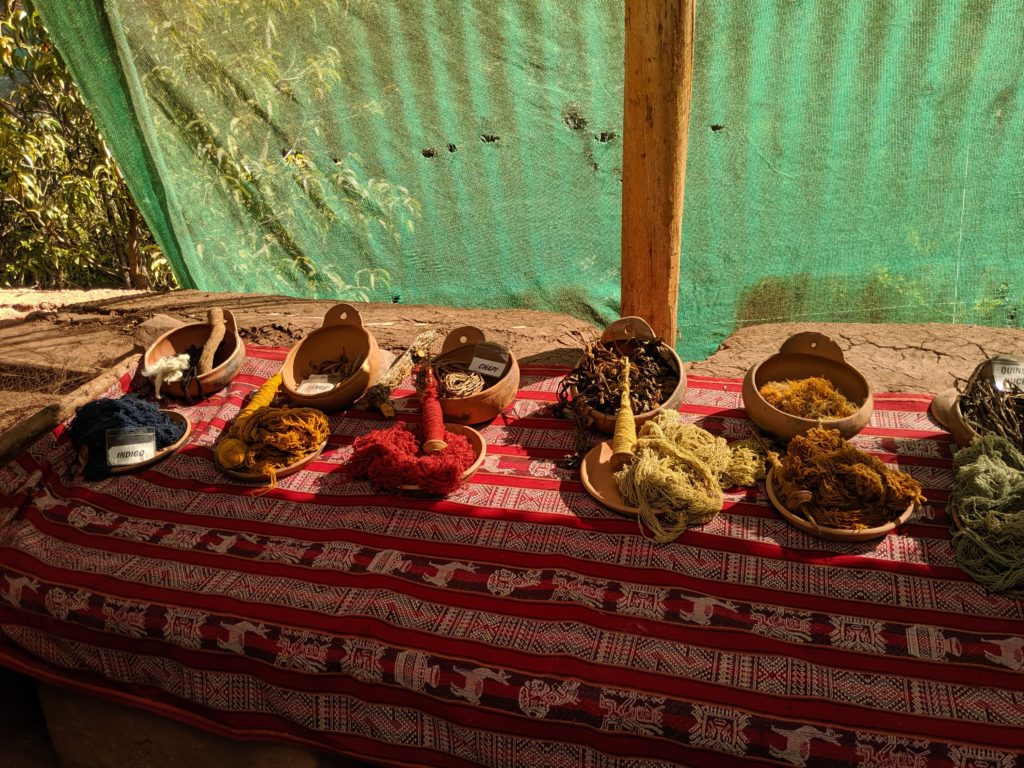
Natural dyes 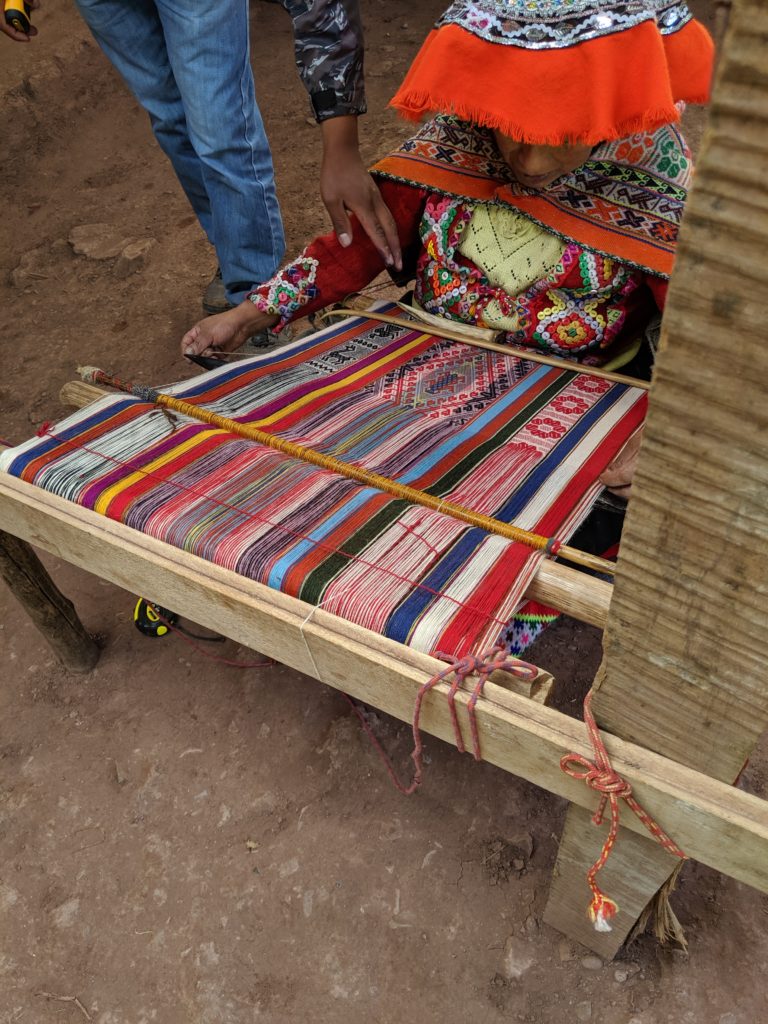
Weaving
Awana Kancha
Our next stop is only 5 minutes down the road, the Awana Kancha interpretation center. This is a self-guided walk-through spot that is sponsored by 14 local groups of craftspeople, showing different weaving techniques and displaying the various types of camelids in Peru. There is a small area with the same dyes and yarns we saw at the last place, so Freddy skips over it. We watch a couple of local women weaving beautiful textiles. And then we go to the animal enclosures.

Learning about the camelids 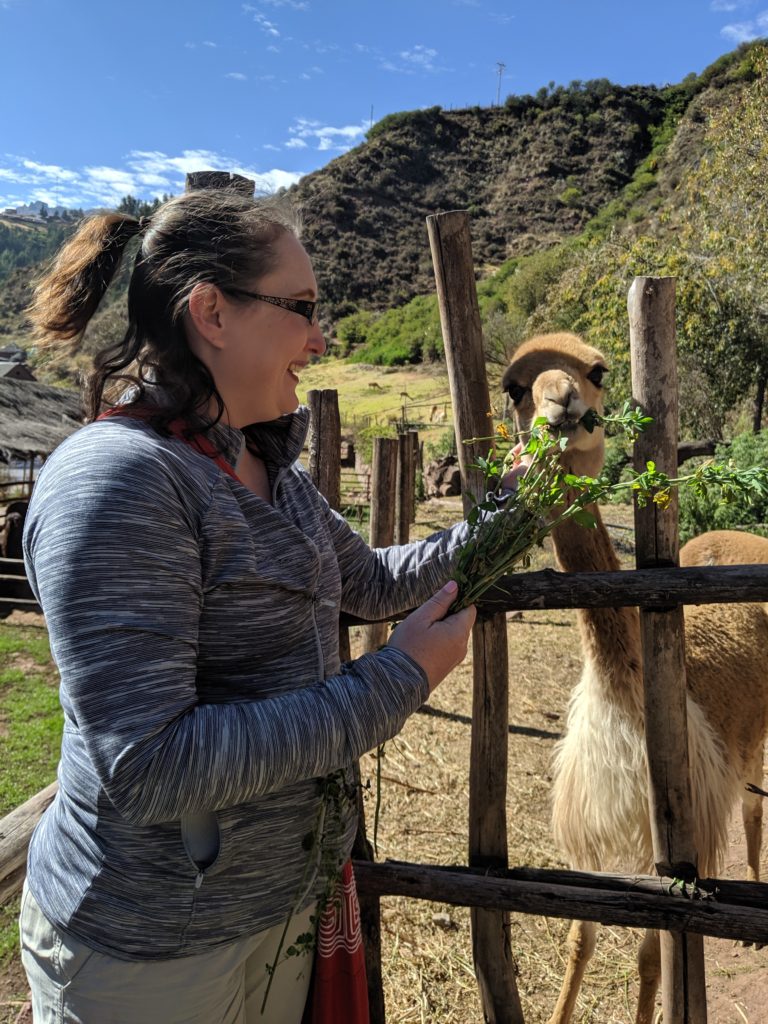
We start with the vicuña 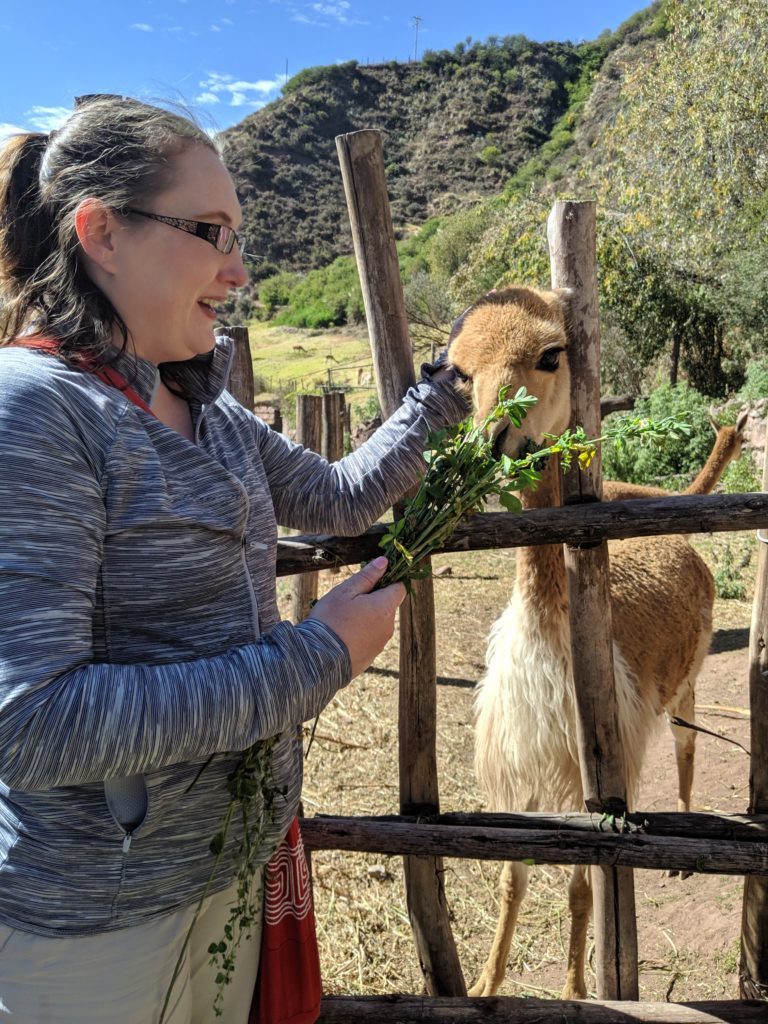
So soft 
Also does not like you to touch how soft it is 
Look at this guy’s ears 
Are you talking about me?? 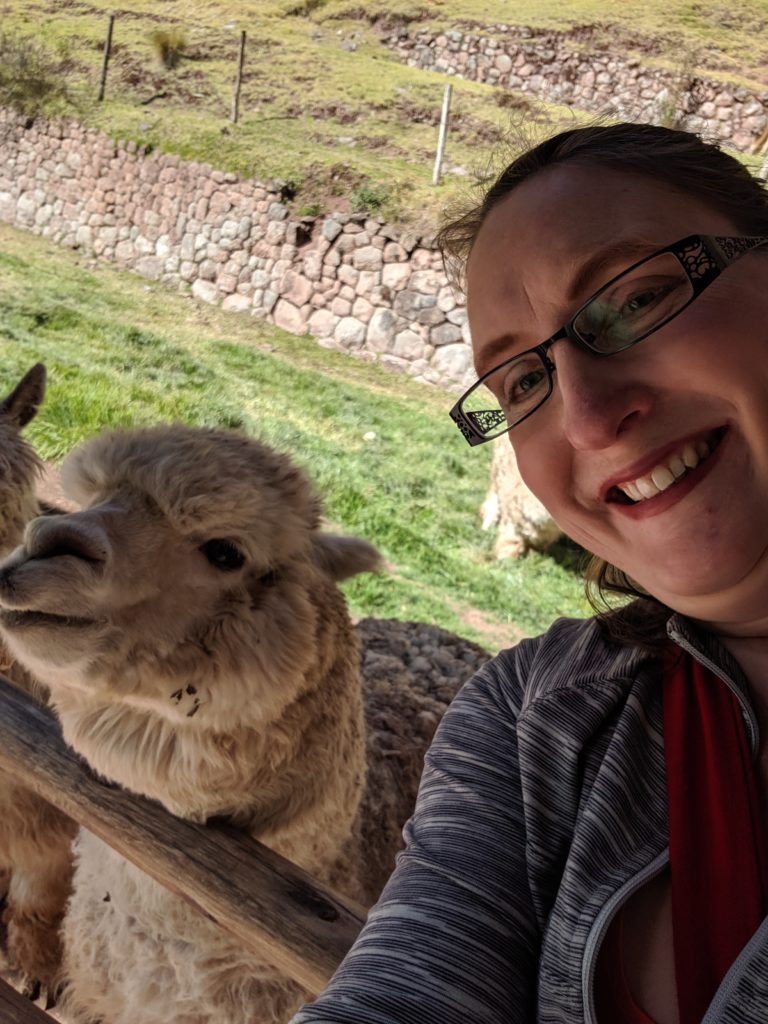
Then we met the fluffy bois 
So fluffed 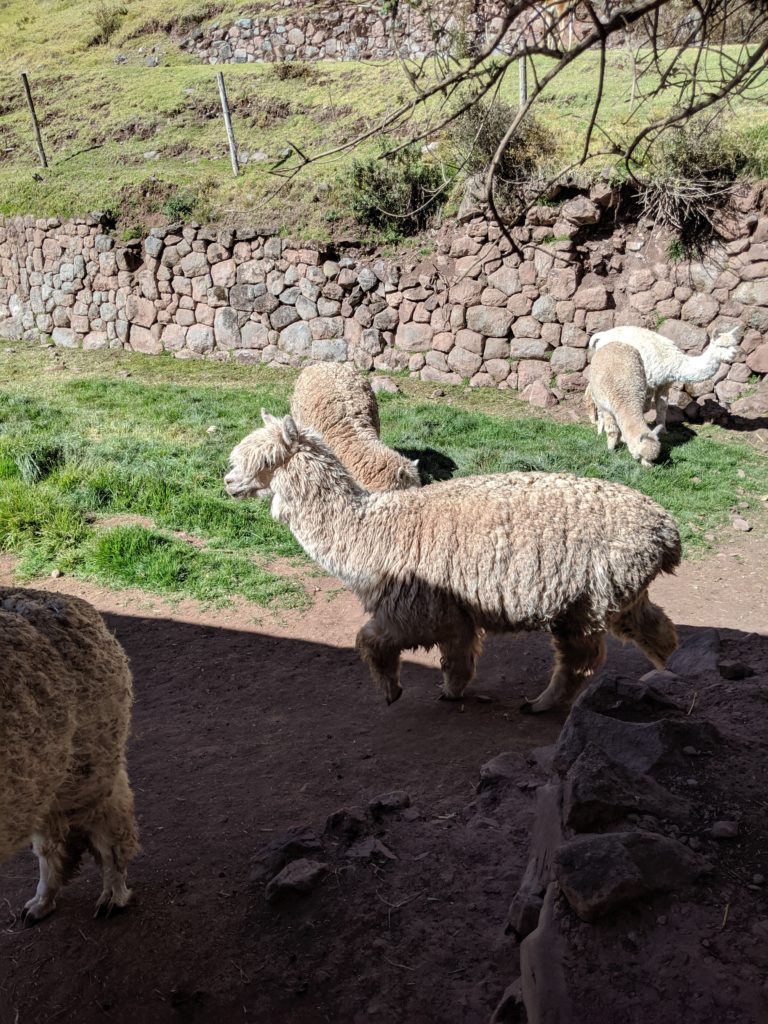
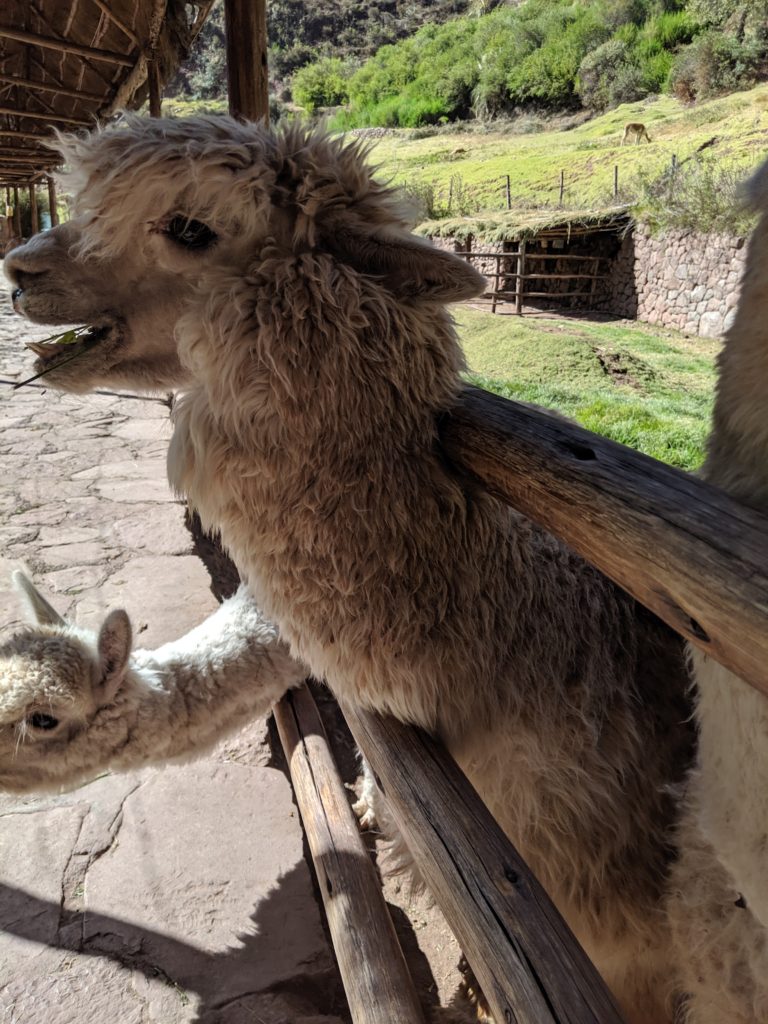
Flooofeeeee – I feel like there was a ‘floof’ sound when it put its neck through the fence 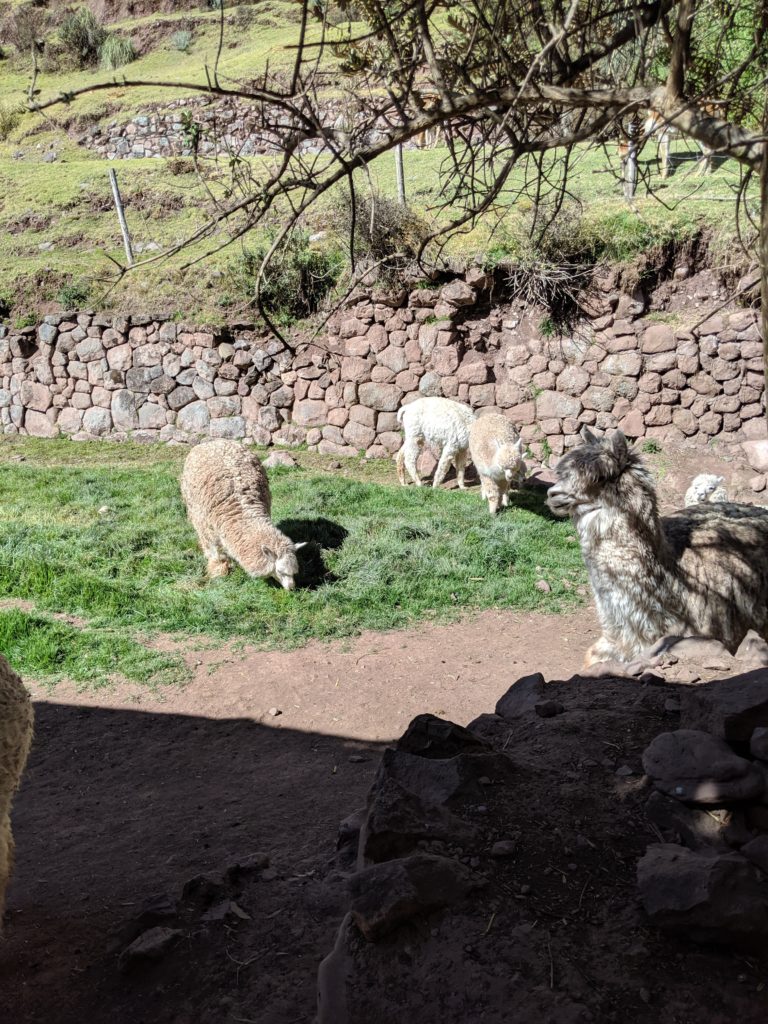
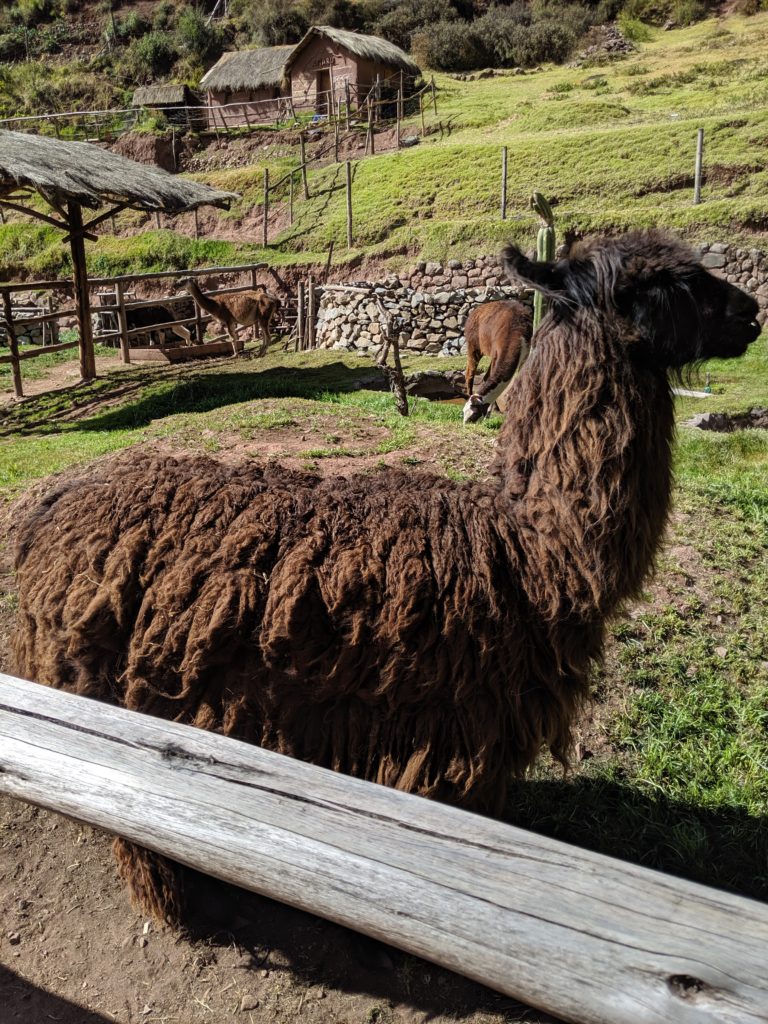
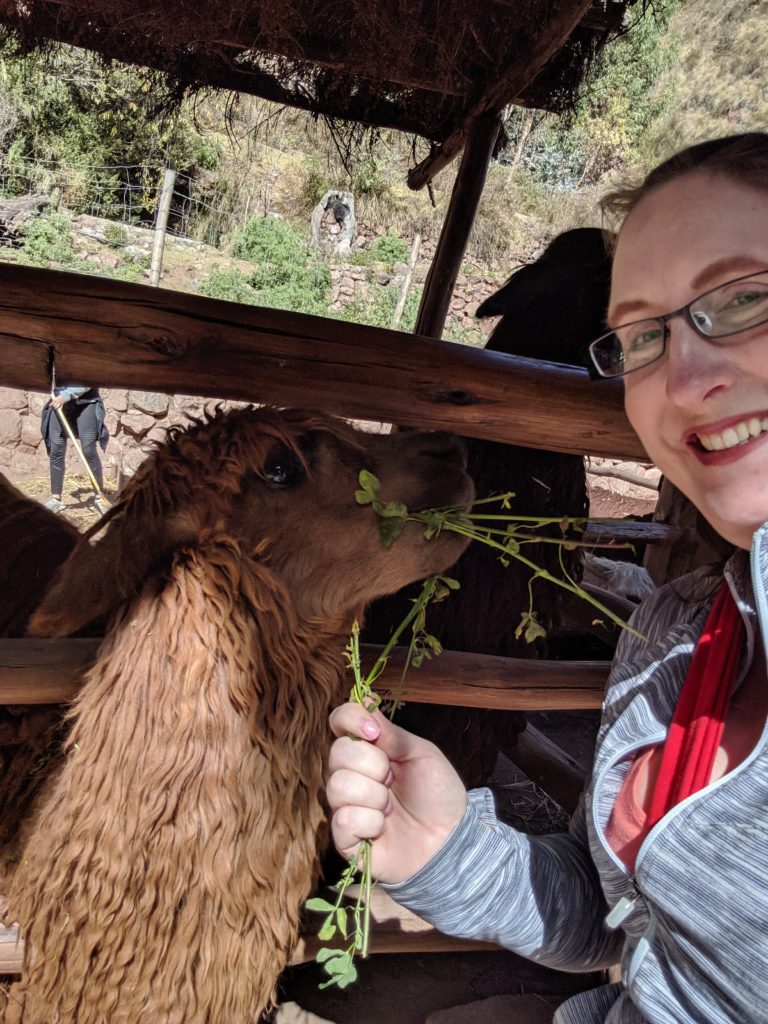

Yummy 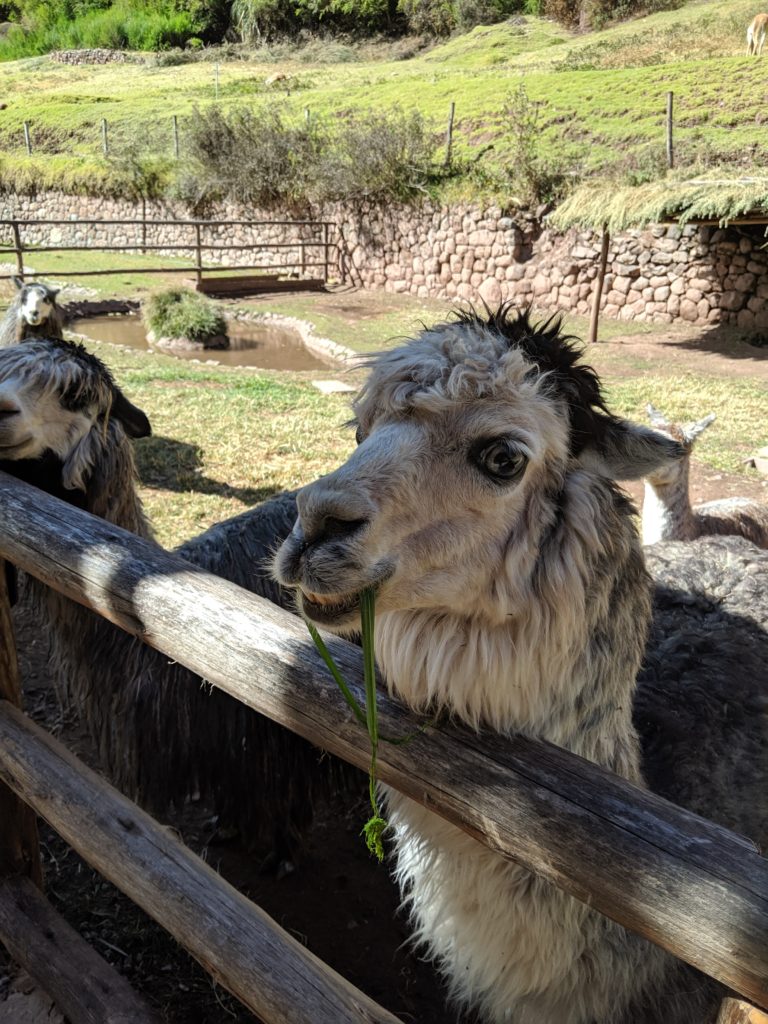
And look at this guy’s handsome face 
He knows he’s photogenic 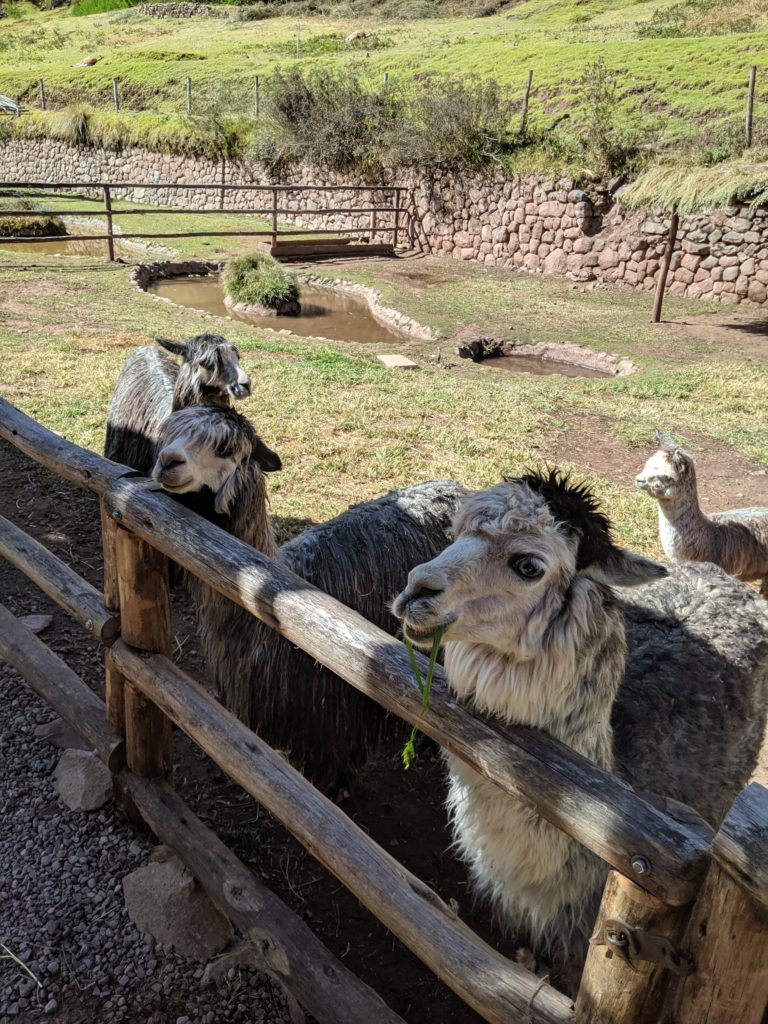
The prettiest llama 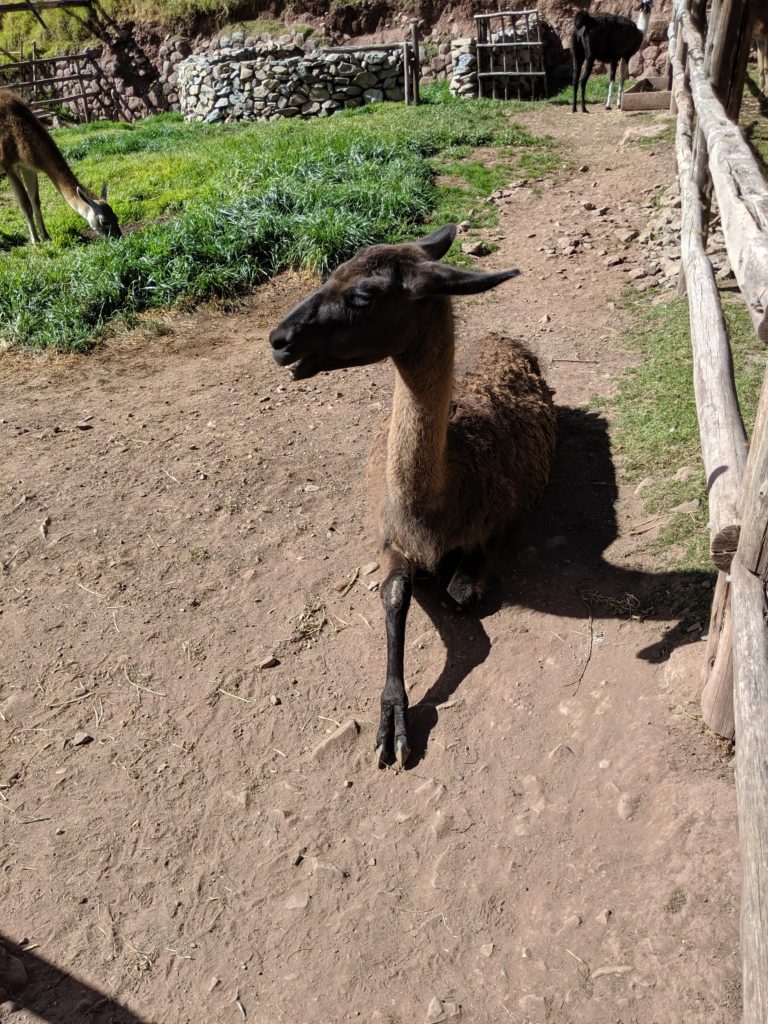
Relaxing in the sun 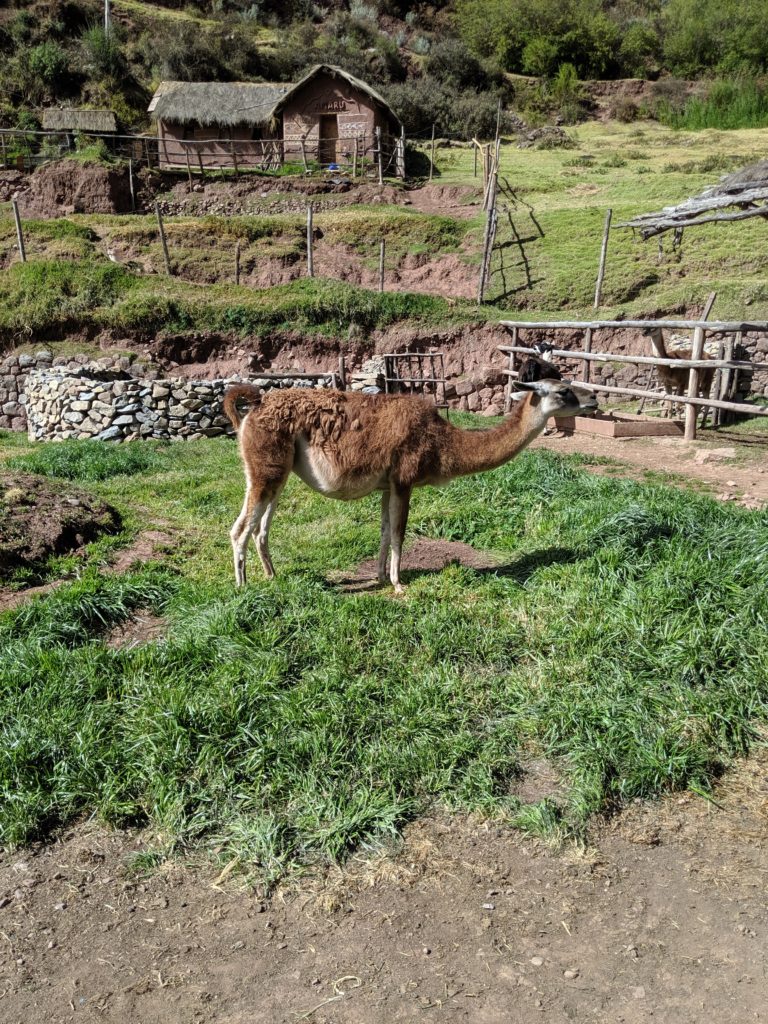
Mama llama 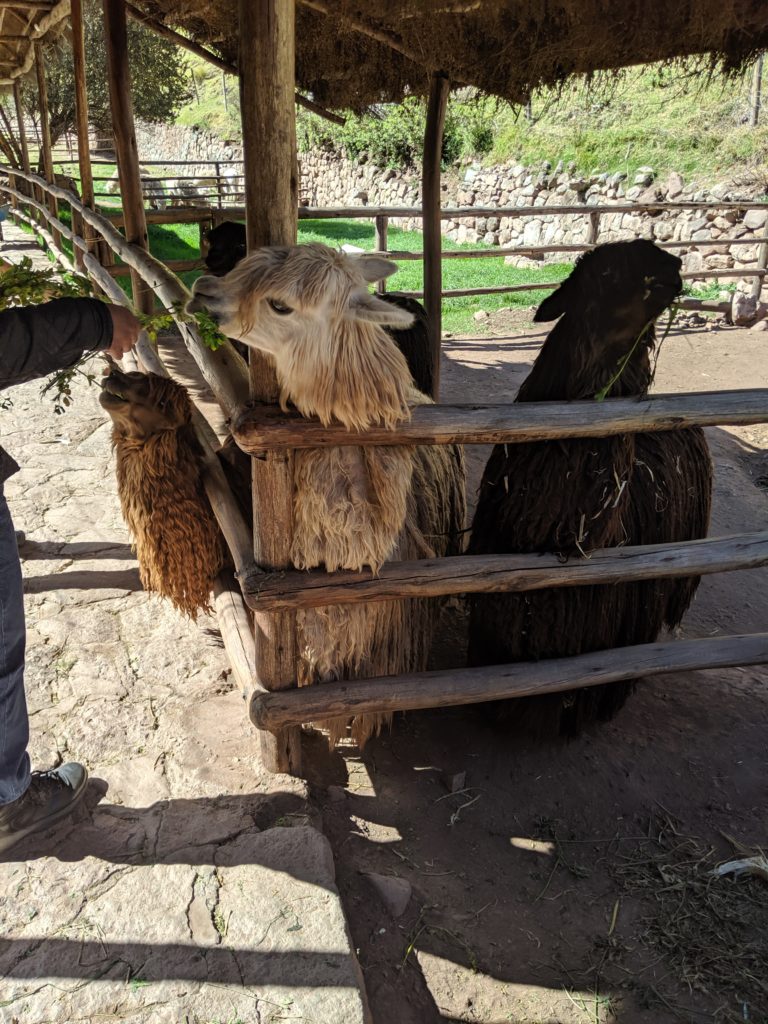
First, we pet the vicuñas. We can’t go into any of these enclosures, but all of the llamas and alpacas are happy to come stick their heads over the fence for a piece of alfalfa and a photo. After the vicuñas, the llamas and alpacas are separated into different enclosures. And each type of llama and alpaca are also separated. So there are cute short-haired ones, and big fluffy ones, and ones that have dreads. Just a good variety of the types of wool that come from the different animals.
Deeper into the Valley – Pisac Ruins
From here, we drive for half an hour or so, along mountain roads, down, down, down into the valley. We stop at an overlook point and take some photos. You can see the squares of farmland and the wilderness, sans squares. Many areas are yellow with corn laid out to dry in the winter sun.
We arrive eventually at the ruins of Pisac. This is a terraced farm area from the Incas. There are farmers’ houses and lots of terraces, and on other hillsides, the priests’ houses and astronomers’ houses can be seen. We embark on a 90 minute or so hike through these ruins. Now, everything here is terraced because it’s in the mountains, so there is no hike that is just hiking. It’s all stairs. Uneven stone stairs that are hundreds of years old. It’s not a grueling hike, but definitely not an easy one. Also, this is clearly one of the main stops that tourists are taken to on their journey to Machu Picchu. So there are lots of people here. This is where Freddy is again, super awesome. He is incredibly patient with me whenever we’re going up stairs and I am out of breath. He finds something to stop and point at and talk about, seamlessly giving me a chance to drink some water and breathe. He is also very aware of the large groups of 30 tourists from the tour buses following one guide with a flag, who has to yell over the group. He finds a reason to step aside and look at some plant or take a different path so we aren’t swallowed up by this sea of people.
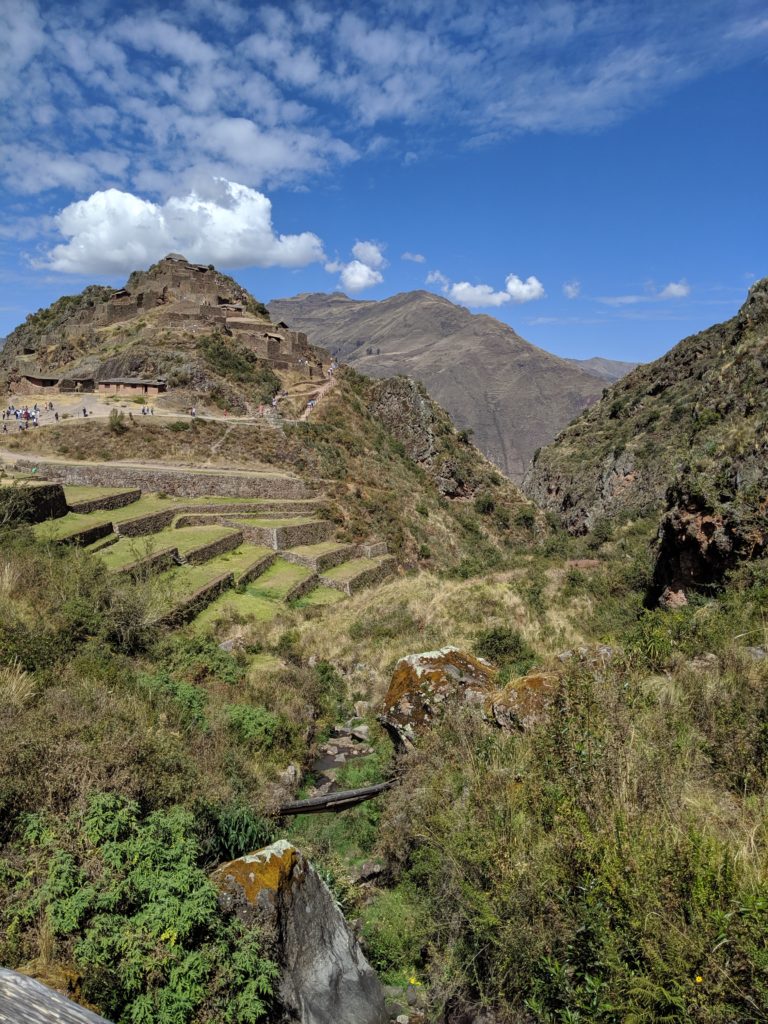
The Pisac ruins 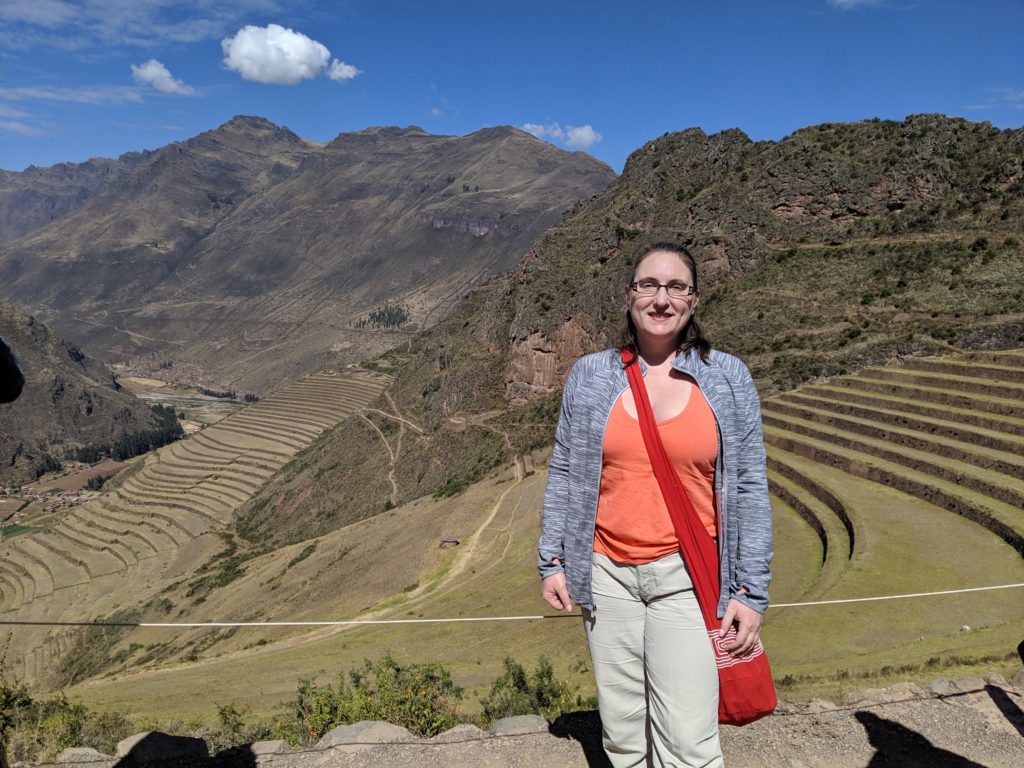
We started here, at the top of these terraces 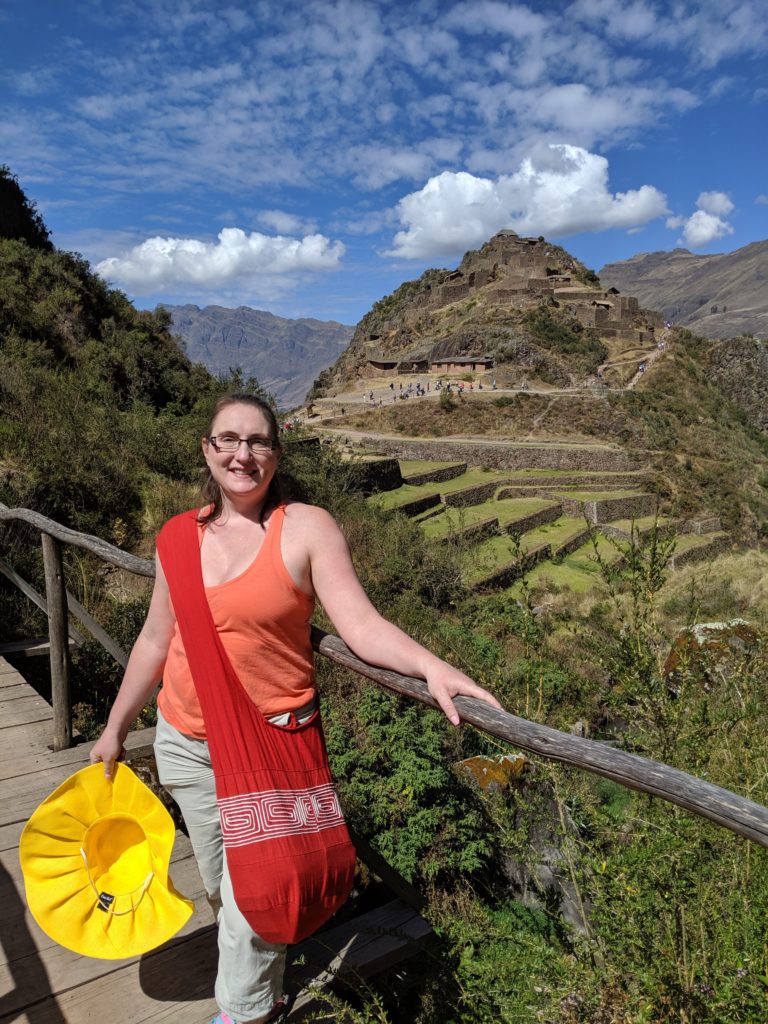
And kept hiking up to the top 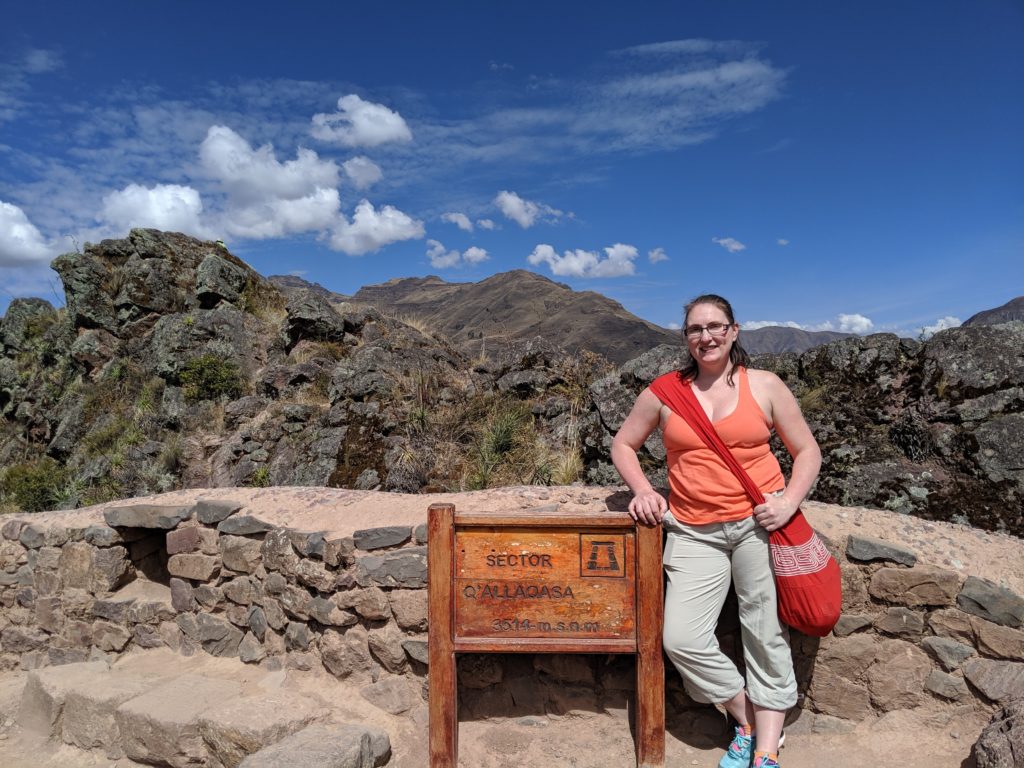
The top! 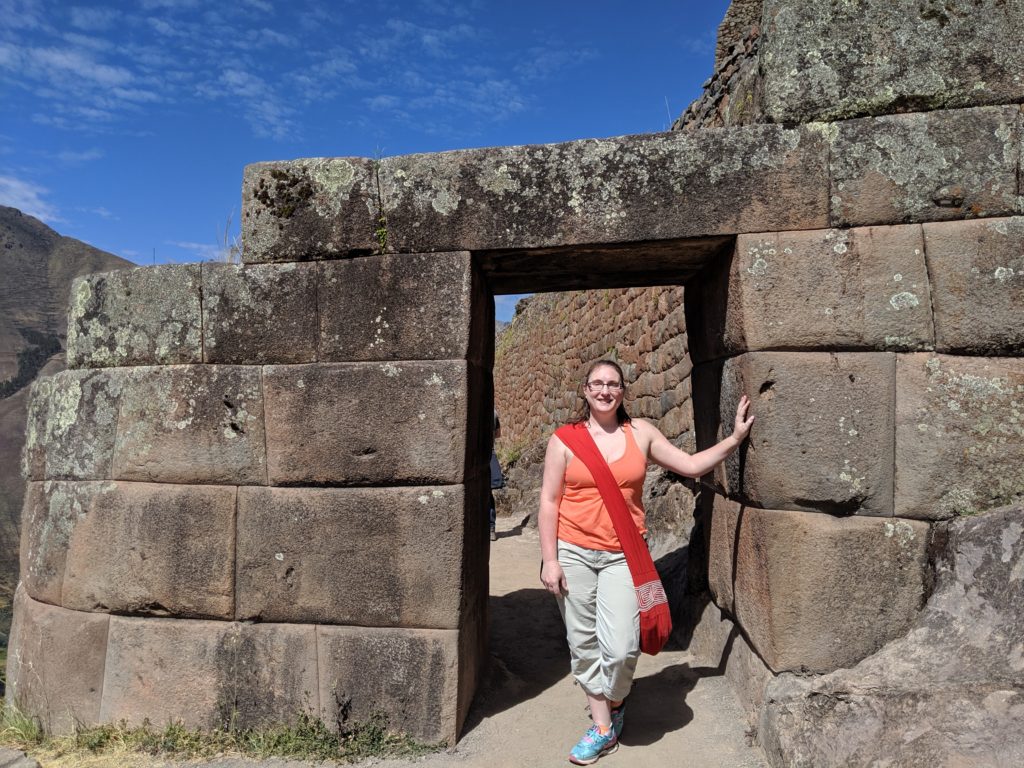
Inca doorway 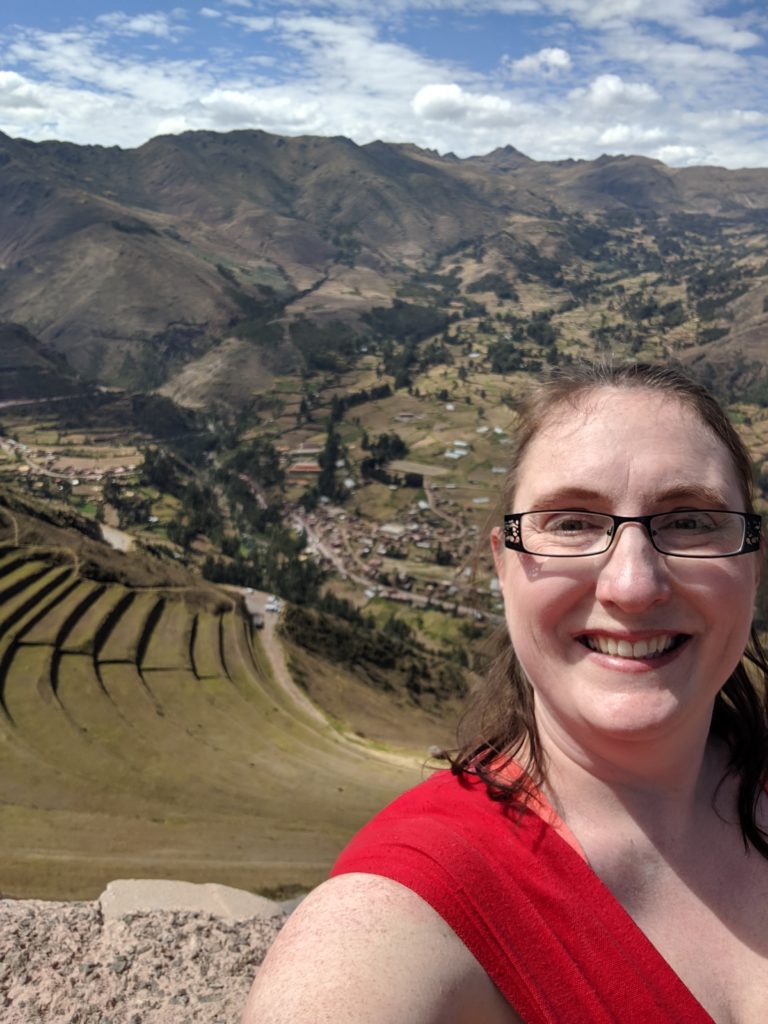
The view from the top 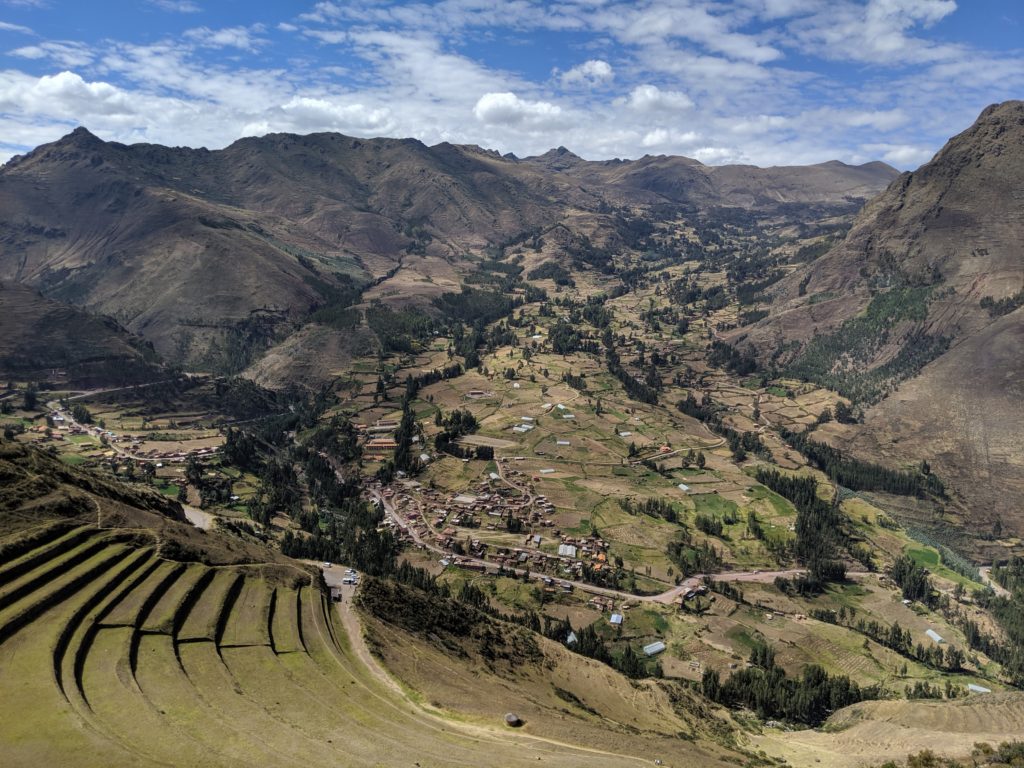
Beautiful valley and terraces 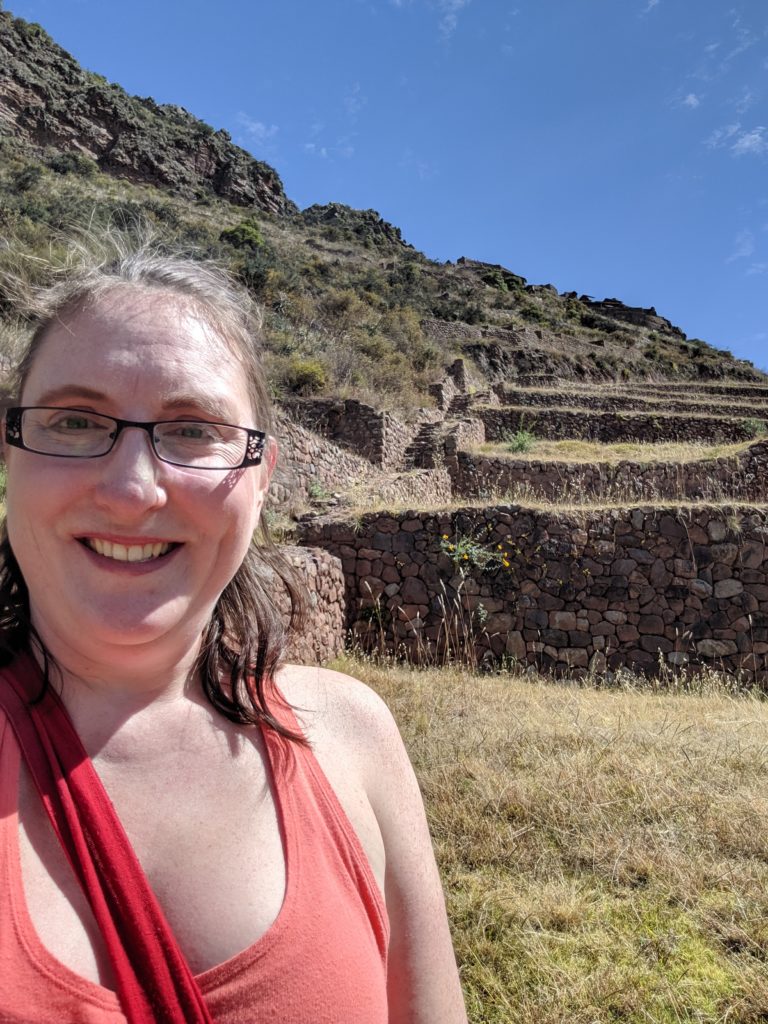
And the sweaty hike back down
Freddy is also from the Benjamin Waters school of hiking. As we arrive, he says, ‘Oh, we’ll only go about halfway up’ (not that I complained or requested not to do any strenuous hiking). And as we’re climbing stairs and learning about irrigation and architecture and stone carving methods and quarries, he keeps saying ‘only a bit more’, as we continue to ascend, before finally saying “Congratulations, you made it to the top.” Haha, good one Freddy. We look out across the valley and at the beautiful terraces and then start our descent. It is, of course, faster to go down than to go up, and the route is more direct, but also, we were dropped off at about the mid-height point of the ruins, hiked to the top, but our pick-up point is at the very bottom of the terraces, so the hike down covered a bit more altitude, though not more distance.
Market place
Our next stop is at the bottom of the valley, and we go into a small town and tour the market place. There are lots of farmers selling vegetables, the ubiquitous potatoes and corn, along with some fruits, flowers, and grains. There are several shops that sell fruit juice, as there are in most cities. I think other cultures drink a lot more fruit juice than we do because I find it quite strange to have a shop that sells only juice. As we drove here, there were many backpacking hostels and minimalist places to stay. So this market and the surrounding cities is where all the crunchy granola type tourists hang out, swathed in mixtures of colorful Incan prints as well as tie-dye and mandalas, blonde dreadlocks and purple hair, happily sitting on the floor eating from the food stalls in the market with the locals. There are also signs for several ayahuasca retreats in this area. We continue walking through the market and get to a guy with a clay oven, making empanadas. Freddy says these are his favorite empanadas, so we buy a couple and have them as a pre-lunch snack. They are absolutely delicious, nice crispy flakey crust, full of cheese and tomatoes and onions. After all the hiking, it’s almost 1 p.m., and I am starving, so even better. Next, we walk to a silver shop and there’s a demonstration of how the local craftspeople make jewelry and items from silver. This is…. the typical tourist spot where you take the tourists for a ‘demonstration’ and then leave them there to shop. However, unlike most of this type of place that I’ve been to, it’s not like Ikea with one entrance and exiting only after going through all of the jewelry cases, and Freddy is very clear that we can just leave and I don’t need to buy anything. So … bonus points for that. But also, the markets and the bargaining and the general process of buying things and determining their quality and origin is pretty exhausting. It was kind of nice to have a clean, well-laid out shop to browse, so I ended up buying a pair of llama earrings made of local silver as well as local semi-precious stones. I then wander the textile market for 15 minutes or so before we get back in the car and drive to lunch.
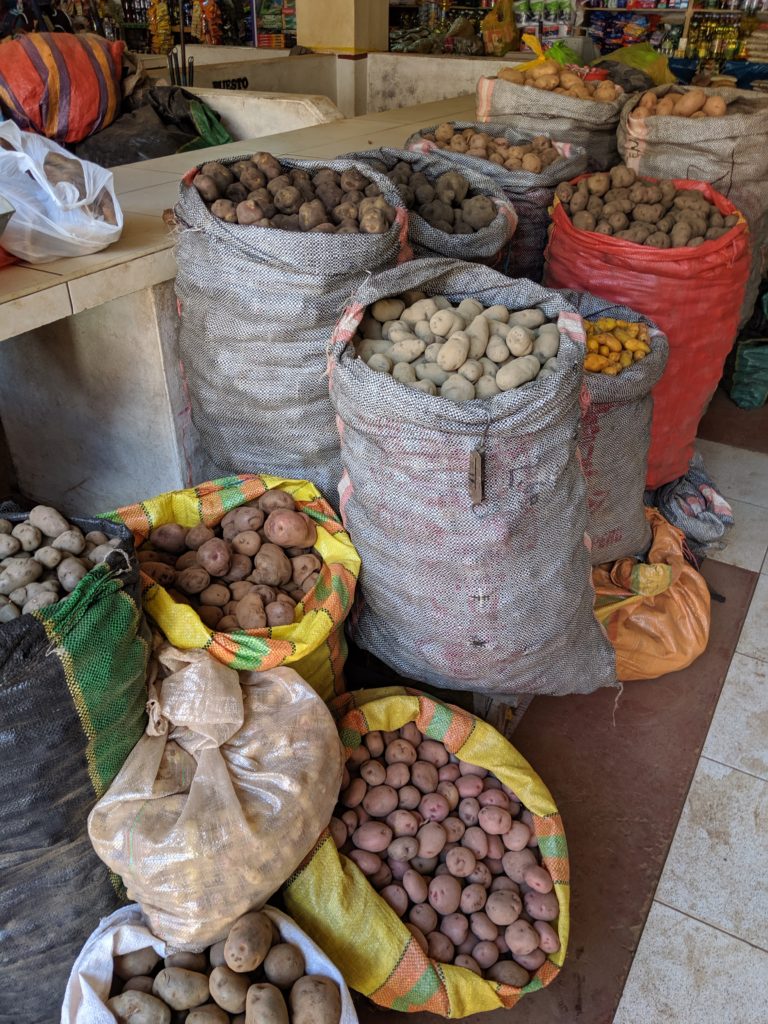
Potatoes in the market 
Clay oven for empanadas 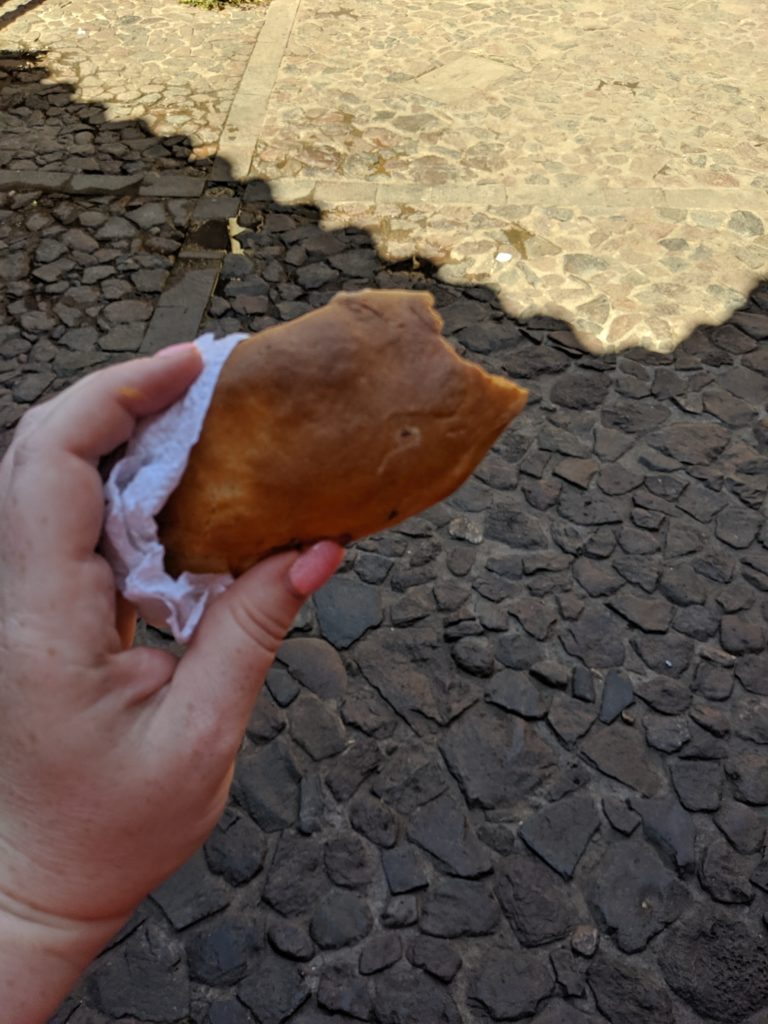
Delicious empanada 
Guinea pig houses
Lunch time
As we are driving to the restaurant, Freddy asks if I had specifically requested this place. I said no, that the tour company had arranged it. As we arrive, I see now what his concern was. This is a tourist buffet restaurant, generally the worst of all restaurants. There are giant buses outside, and I feel like I’m the only person there as a single person rather than a huge group. This is a pretty sad oversight on the part of the tour company, as I’d never send a single tourist or a couple to one of these types of restaurants. But, we are here, so I make the best of it.
I went to the restroom to wash my hands before lunch, and I see a few tables outside in the courtyard. Inside the restaurant are huge tour groups, and there’s a live band playing, so it’s super loud. So I ask if I can sit outside, and they put some silverware and placemats out there for me. In the end, the buffet was ok. There was a good amount of variety, and the food was mostly local cuisine rather than tourist food. And also, since being at altitude, my stomach has been completely refusing to digest meat. They tell you that you digest slowly at altitude, but my stomach is like meat === rocks. Also, sweet potatoes somehow have become like dry cotton. So my body is telling me to eat juicy things…. mashed potato causa is cold and refreshing and becomes one of my favorite foods. And fruits. I just crave and eat fruits. So I enjoyed a couple of servings of a mango salad, along with some corn and potatoes, a yucca croquet, and tried a bit of chicken and beef. But I sat outside, with the breeze and the sun and the mountains and the clouds and enjoyed the chicha morada in quiet, and I was quite content.
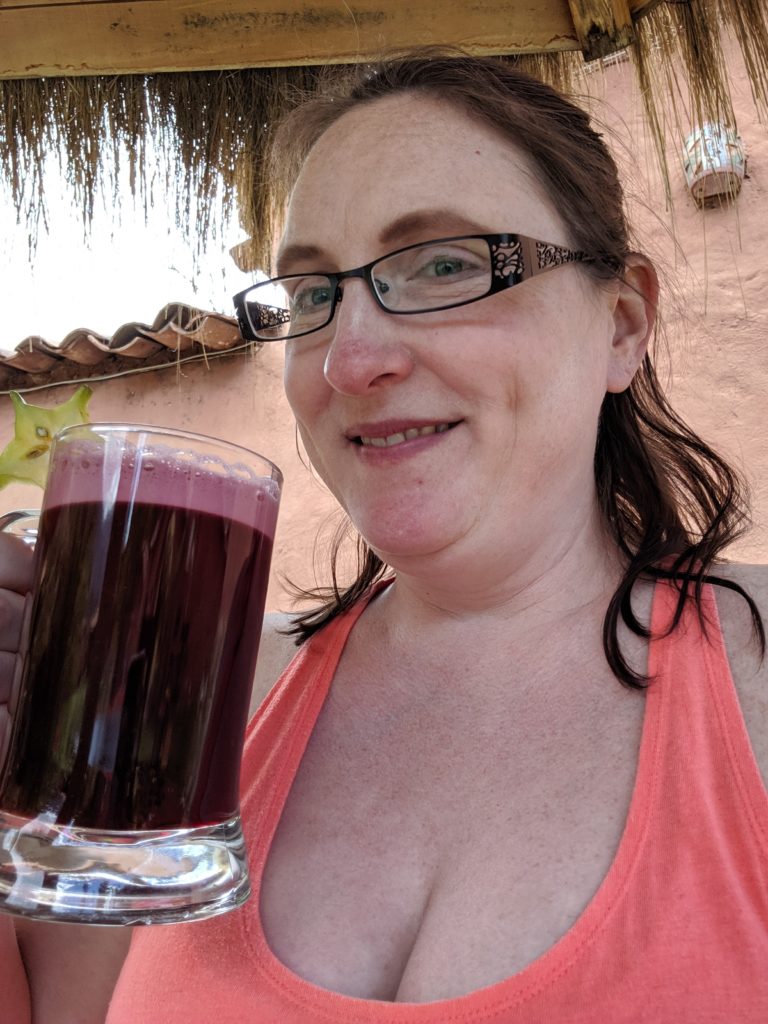
Refreshing chicha morada 
Beautiful view
Ollantaytambo Ruins
After another half an hour of driving, we arrive at our final stop for the day: the ruins of Ollantaytambo. Here, we walked through the ruins, but didn’t do too much stair climbing. It was mid-afternoon, and high point for tourists, so we visited the lesser-well-known parts of the ruins. We walked and followed the water as it poured through ancient irrigation systems. We looked at the stone carving of different fountains. There were even a couple of llamas in the square, so we visited them as well.
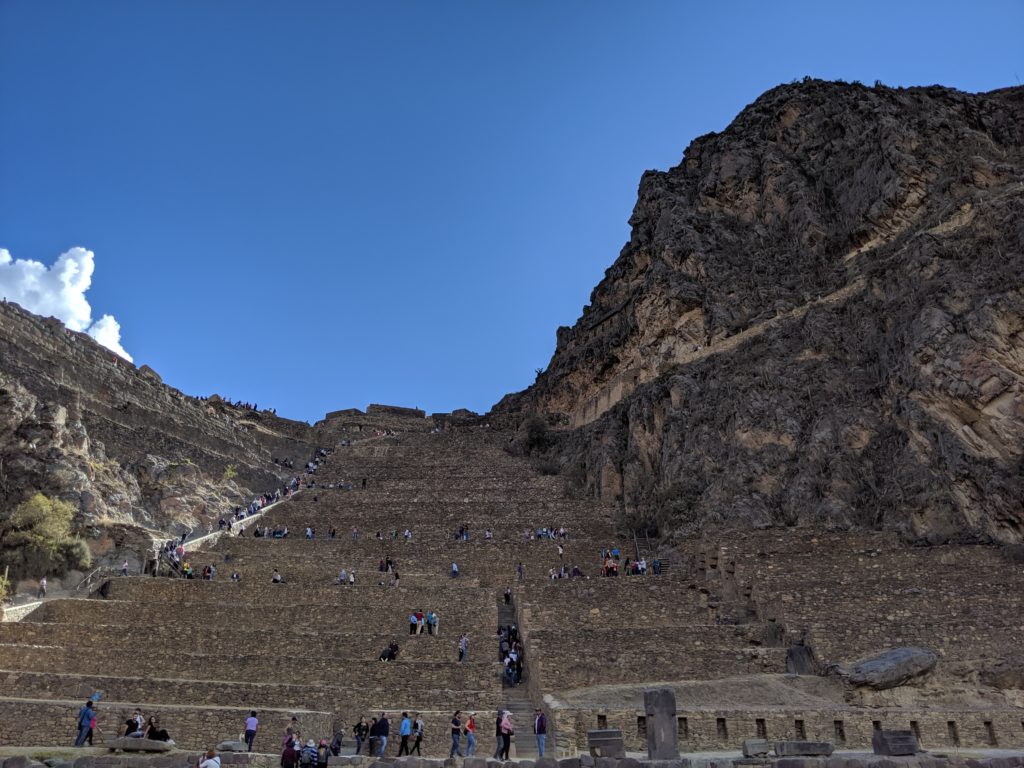
Ollantaytambo ruins 
Stairs – so many stairs 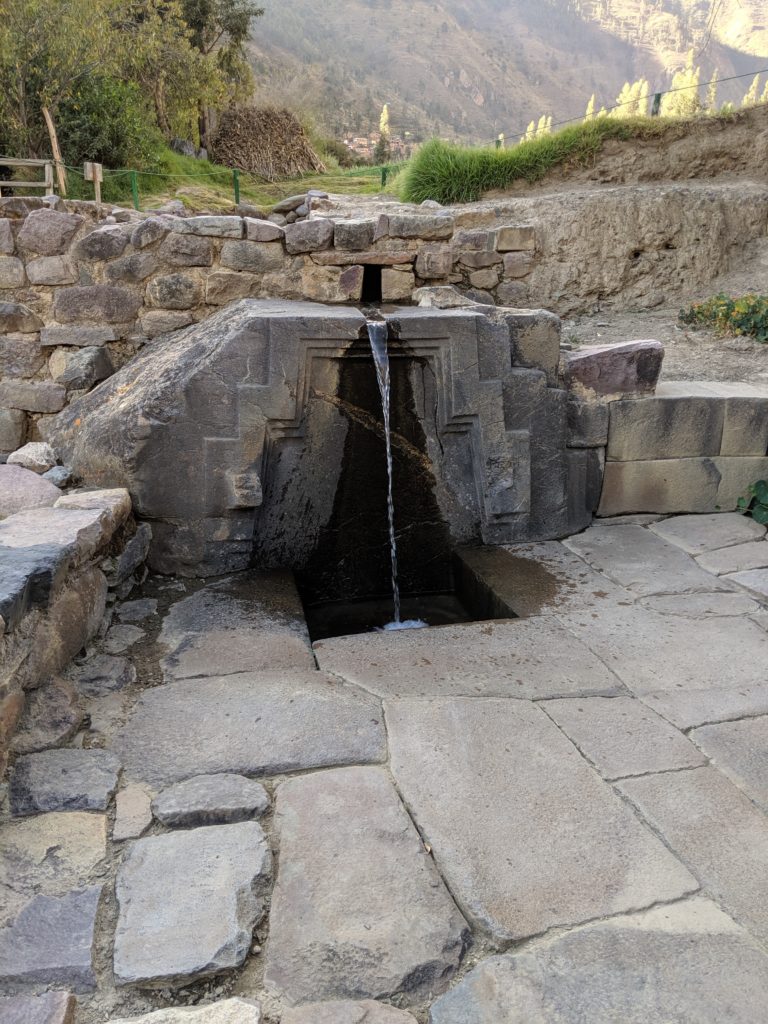
A water fountain 
A beautiful stream 
Llamas 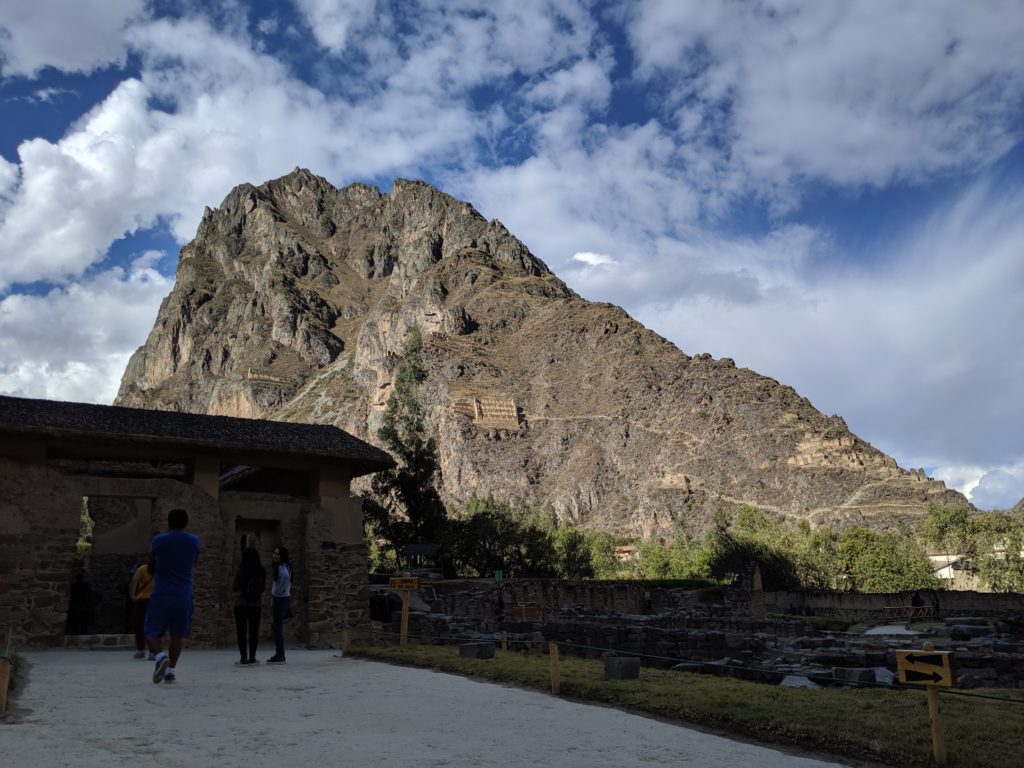
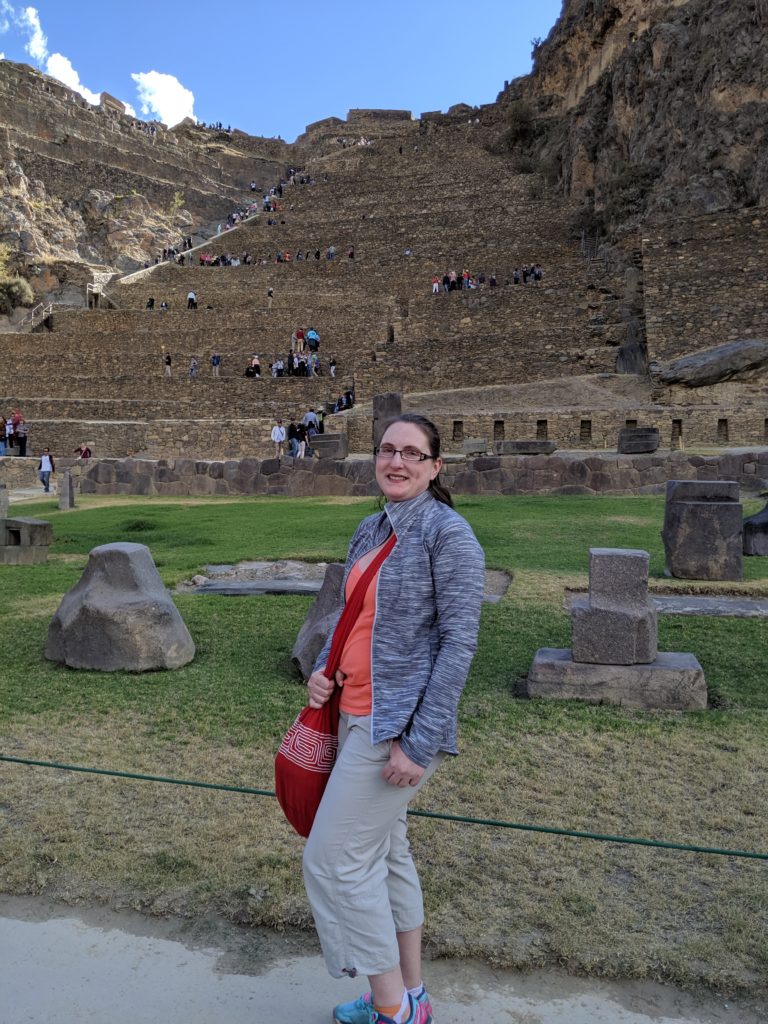
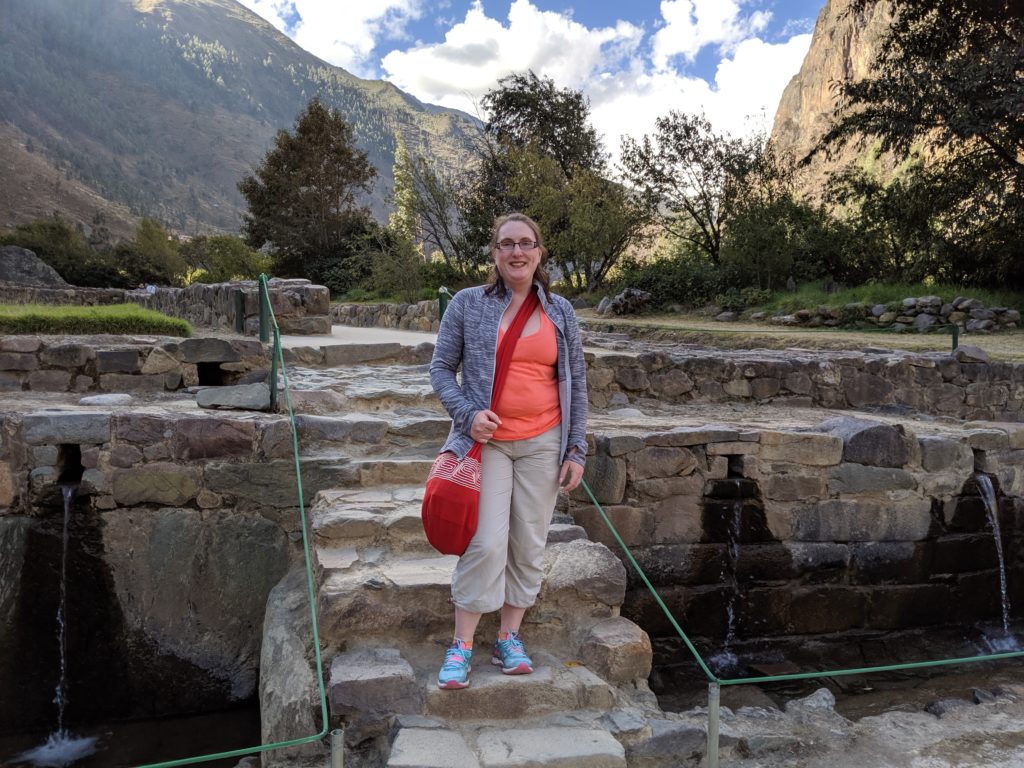

Aranwa Hotel
From there, we drove back to the hotel and they dropped me off at around 5 p.m. I checked in and just spent the evening at the hotel. The hotel is a beautiful, sprawling resort on landscaped grounds, but it isn’t in a town, so there’s nowhere to walk to if I had wanted to go out anyway. It’s rather isolated. When I arrived, there were some llamas grazing on grassy hills, but the groundskeeper was putting them in their pens by the time I got back from checking in and dropping my things in my room.
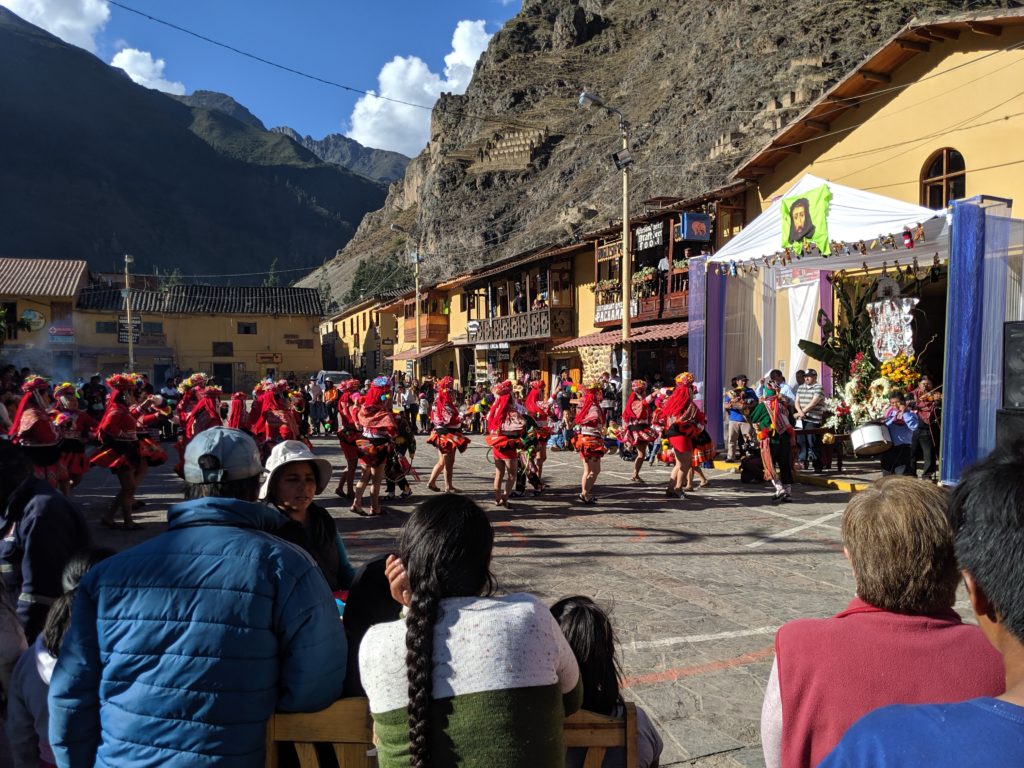
Dancing in the town at Ollantaytambo 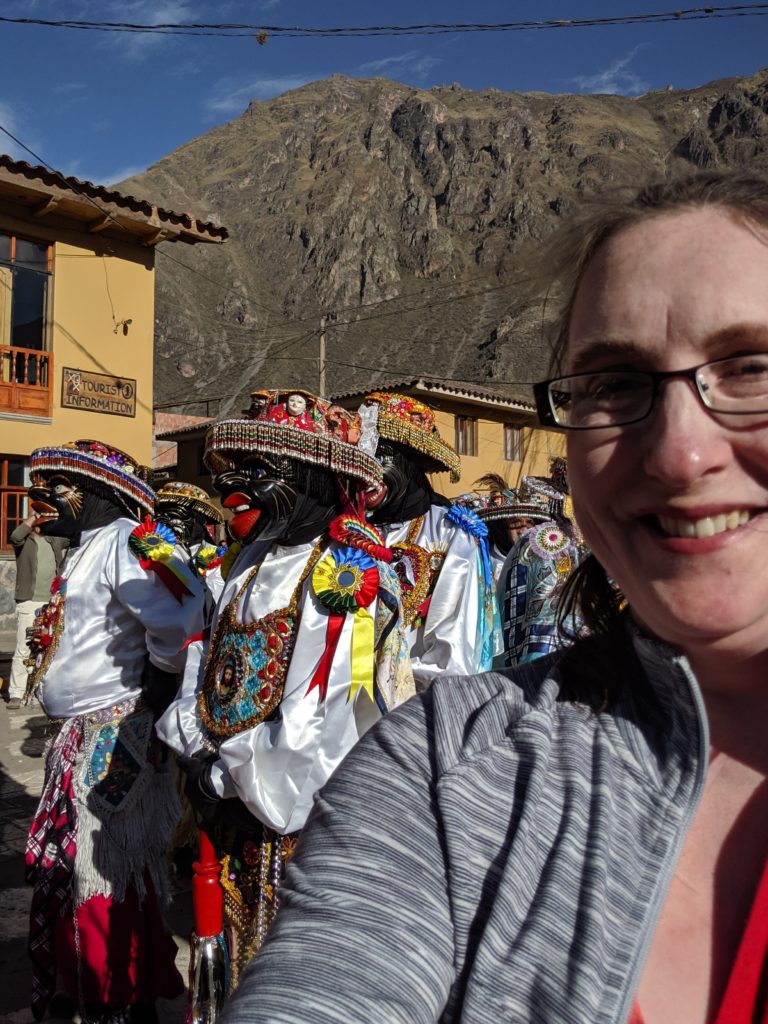
Condor masks 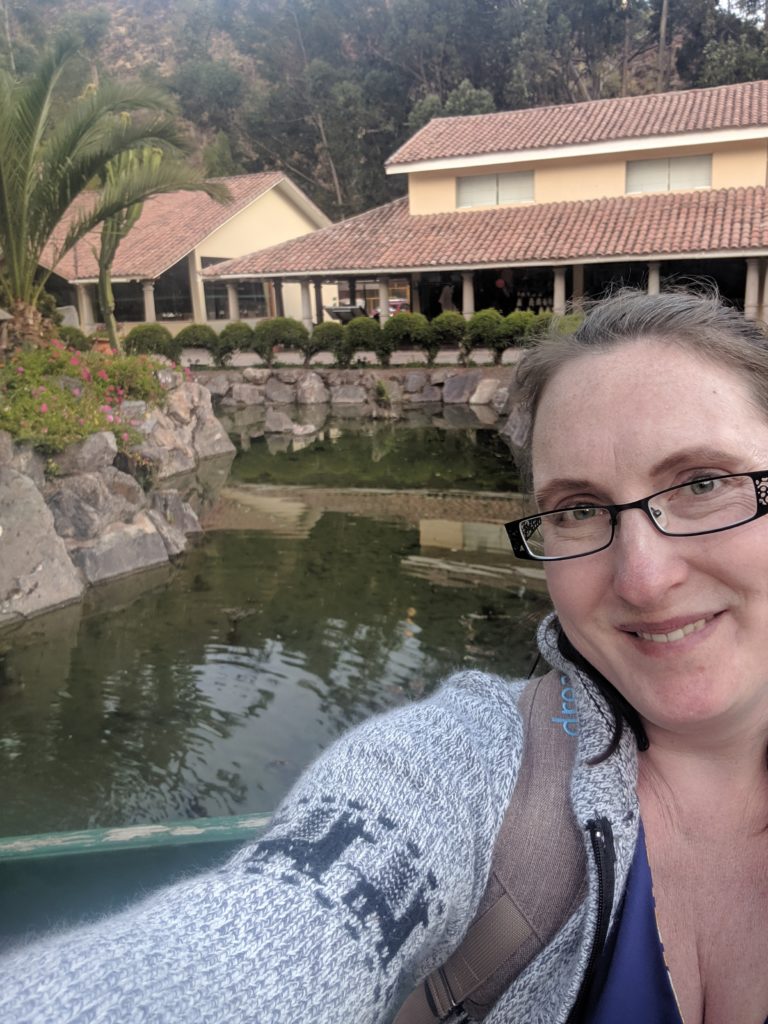
Lovely hotel grounds 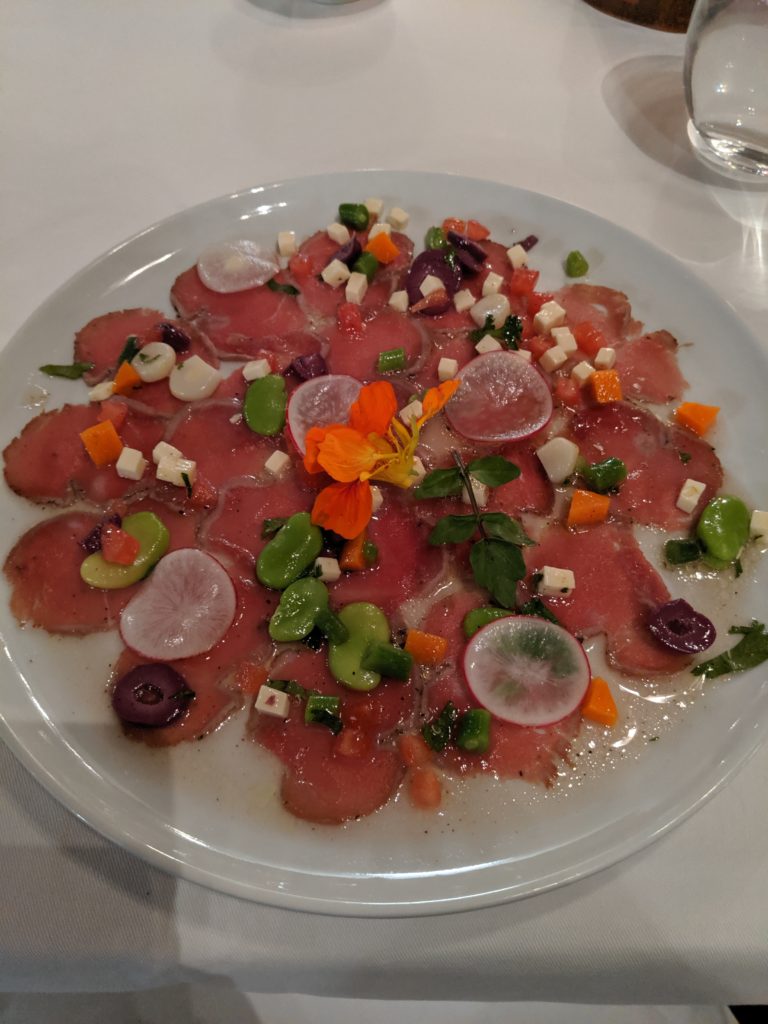
Alpaca carpaccio 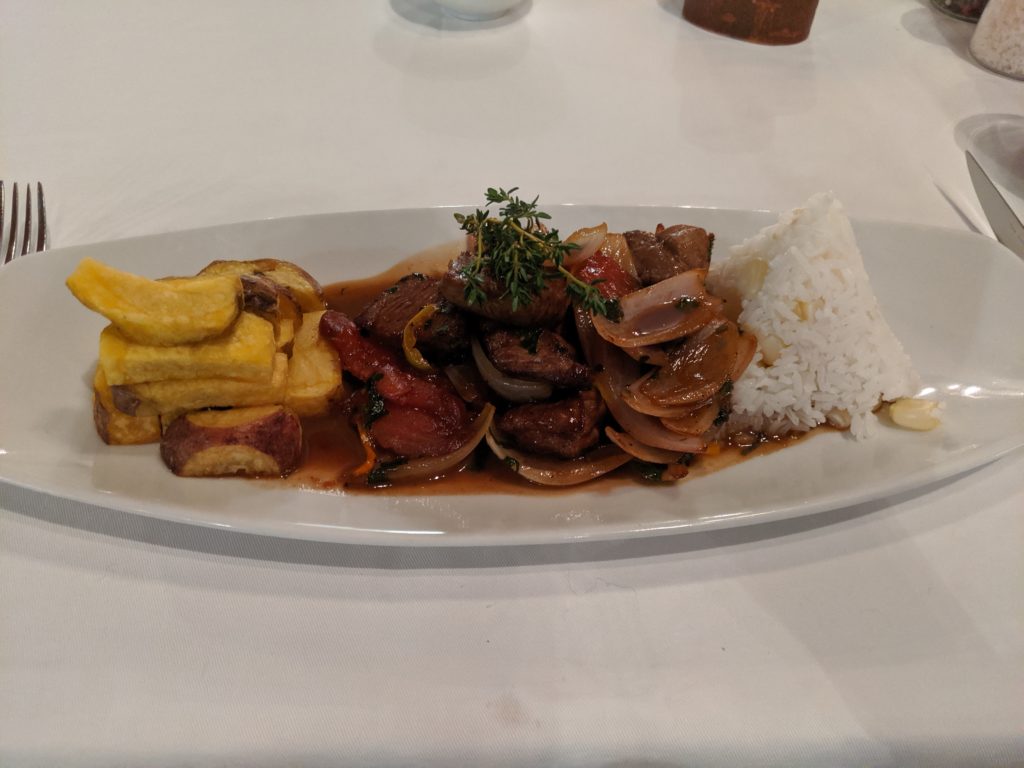
Lomo Saltado
I just took my laptop and sat outside and wrote about my day in Lima while having a drink from the pool bar. I made myself a reservation at the hotel restaurant for dinner at 7, so I moved the party inside for that. For dinner, I started with an alpaca carpaccio, which was ok. I mean, yes, clearly I am a monster. But also, I think it was more of an alpaca ceviche. Even though it was sliced like carpaccio, it was lime juiced like a ceviche. After that, I enjoyed a plate of loma saltado, which is beef loin with tomatoes and onions, served with rice and fried potatoes. Apparently it is a very Peruvian tradition to frequently serve both rice and potatoes. I guess I’m carbo-loading for my hike to Machu Picchu tomorrow.
Thoughts on Sacred Valley
Anyone who knows me knows that I love to travel for the people and the culture. I am rarely discussing the majesty of the nature around me or the architecture of the buildings. I love the festivals and the foods and the local customs. But, this day has been quite different.
This valley, perhaps many spots in the Andes, are just unimaginably beautiful. The feeling of standing there, looking up and looking out, is similar to the overwhelming feeling of standing near the ocean and contemplating its vastness. The mountains are so beautiful and so disorientingly large that they seem both close enough to touch and unreachable at the same time. I really enjoyed sitting at lunch and just quietly staring out at the mountains. I’ve never been anywhere or seen anything in the natural world that has made me feel this way, so I was even shocked to find that within myself. I cannot describe it for you in a way that will make it real. It is one of the few intangible, indescribable things left in this world.

Beautiful valley and terraces
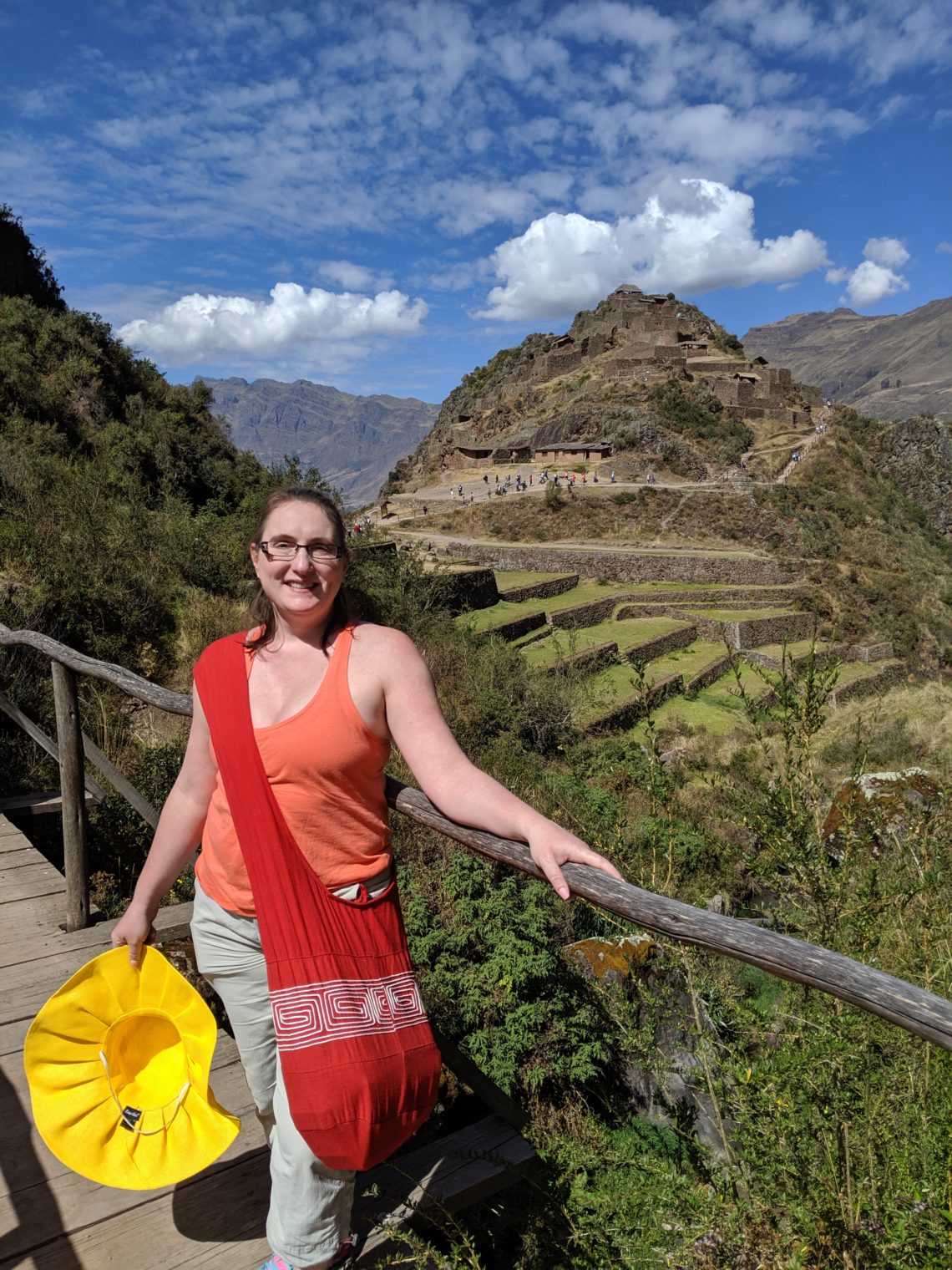



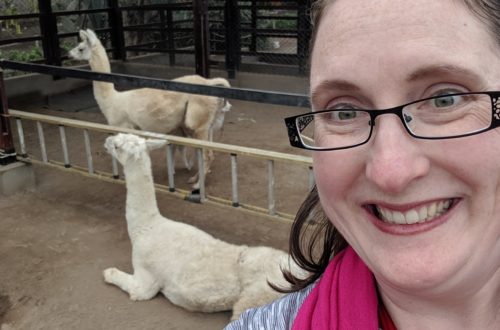
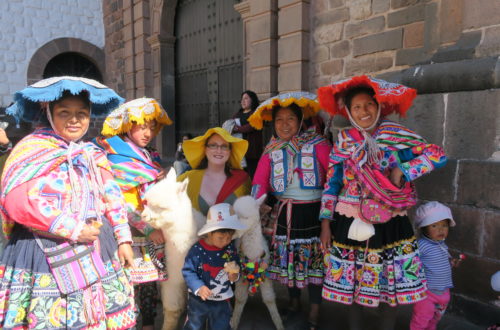
One Comment
Clare Tuma
Me again 🙂 Thank you for another awesome entry, Tina! It is bringing back very fond memories of my own trip to Peru back in 2003. Though I visited different places. And definitely did not see as many llamas or alpacas! You give such a rich description of the people and what you saw. I laughed when you said your tour guide’s name was Freddy (hmmm…his stage name? 🙂 And I had to look up the word “derpy”. New for me. Also it would seem there are several types of “alpacas”! They are indeed so, so cute. I applaud you for traveling by yourself and sharing your experiences with the rest of us. You make me feel as though I am right there with you. Thank you again for all your time putting this together and sharing. 🙂